- Reference Manager
- Simple TEXT file

People also looked at
Original research article, benefit-sharing from protected area tourism: a 15-year review of the rwanda tourism revenue sharing programme.

- 1 School of Wildlife Conservation, African Leadership University, Kigali, Rwanda
- 2 School of Tourism and Hospitality, College of Business and Economics, University of Johannesburg, Johannesburg, South Africa
- 3 Conservation Capital, Nairobi, Kenya
- 4 Rwanda Development Board, Kigali, Rwanda
- 5 International Gorilla Conservation Program, Musanze, Rwanda
The success of protected areas depends to a large degree on the support of local communities living in and around these areas. Research has shown that where communities receive tangible and/or intangible benefits, from protected areas they are often more supportive of conservation. Rwanda introduced a tourism revenue sharing policy in 2005 to ensure that local communities receive tangible benefits specifically from protected area tourism and to enhance trust between the Rwanda Development Board (the then Rwanda Office of Tourism and National Parks) and local communities, and to incentivize the conservation of wildlife and protected areas. This study reviewed the tourism revenue sharing programme over the last 15 years, including primary and secondary data, which included interviewing more than 300 community members living around three national parks, as well as other relevant stakeholders. The results show that the tourism revenue sharing programme has resulted in a positive linkage between the national parks and development. Since 2005, ~80% of the funding was used for infrastructure and education projects. The funds are distributed through local community cooperatives, and most local people who are members of these cooperatives had received or were aware of tangible benefits received by the community and tended to have more positive attitudes toward tourism and the national parks. Despite a large amount of tourism revenue being disbursed over the 15-year period, there are still challenges with the programme and the overall impact could be enhanced. Recommendations as to how to address these are presented.
Introduction
Overview of benefit-sharing from protected area tourism.
If structured properly, tourism can contribute to local and national socio-economic development, as well as to conservation, directly and indirectly, within and around protected areas (PAs) ( Snyman and Spenceley, 2019 ). In Africa, particularly in eastern and southern Africa, tourism revenue is one of the major contributors to the financial sustainability of PAs and contributes to local community development, through employment, value chains and revenue-sharing programmes. For example, in Kenya 50% (US$ 30 million) of Kenya Wildlife Services' annual budget is generated from tourism, while in Zimbabwe 80% of the Zimbabwe Parks and Wildlife Management Authority's budget is derived from tourism ( Lindsey et al., 2020 ). Benefit-sharing programmes are often complex, involve numerous and diverse stakeholders, and have challenges in terms of equity, sustainability and good governance ( Snyman and Bricker, 2019 ). It is important, therefore, that benefit-sharing mechanisms and policies are reviewed and adapt and evolve over time to ensure that they are reaching the people who need them the most, and who are most directly and negatively impacted by a PA, mostly in terms of human-wildlife conflict (HWC) or restricted access to natural resources.
It is broadly recognized that the meaningful involvement of communities that live in and/or adjacent to PAs is critical to the long-term sustainability of these conservation areas ( Ahebwa et al., 2012 ; Dewu and Røskaft, 2018 ). Depending on their level of involvement, communities that live in, or adjacent to, PAs can be effective partners in conservation or can exacerbate threats to PAs, and sometimes it is a combination of both ( Kihima and Musila, 2019 ; Störmer et al., 2019 ). Ensuring that rural communities value conservation, through the receipt of tangible and intangible benefits, is critical to the long-term viability of PAs ( Dewu and Røskaft, 2018 ; Störmer et al., 2019 ). The basic premise is that if communities receive benefits, both tangible and intangible, from conservation and tourism in and around PAs, they will be more inclined to hold positive attitudes toward PAs and to conserve natural resources in PAs ( Kaaya and Chapman, 2017 ; Spenceley et al., 2017 ; Dewu and Røskaft, 2018 ; Snyman and Bricker, 2019 ; Ziegler et al., 2020 ). In addition, if local people can earn an income, or receive benefits through community-based tourism revenue sharing programmes (TRSPs), in turn, they will value wildlife and help protect it ( Wunder, 2000 ; Walpole and Thouless, 2005 ; Munanura et al., 2016 ).
There is no universal definition of revenue sharing. For the purposes of this study, we refer to the definition provided by Franks and Twinamatsiko (2017) : “ Revenue sharing is concerned with the arrangements for sharing a proportion of the protected area's income with local stakeholders to provide an incentive for them to support conservation .” In this study, stakeholders refer to indigenous and non-indigenous people that live within and/or around PAs.
Revenue is usually understood to be gross income rather than net income after the deduction of costs ( Franks and Twinamatsiko, 2017 ). The revenue shared may be in the form of cash payments but is usually disbursed in the form of small grants for selected projects. These may be projects for individual community members (i.e., micro-enterprises, school bursaries) or group projects that benefit part or all of the community (i.e., support for school infrastructure, road repair / development, or clinics).
Despite the benefits of revenue-sharing from PA tourism, there are also numerous challenges. Spenceley (2014) identified six key challenges with benefit-sharing from PAs, several of which were identified during this study as well. These include: (1) the value of money per person is small if divided among a large number of people; (2) benefits of social infrastructure (e.g., schools, water, infrastructure) are not always associated with the conservation or tourism; (3) those who benefit are not necessarily the same as those who experience the costs of conservation, [e.g., human-wildlife conflict (HWC) and loss of access to land)]; (4) poorest residents are often not the beneficiaries; (5) community entities may not have the capacity to partner with other stakeholders or to agree on benefit-sharing processes; and (6) legislation may constrain benefit-sharing processes (adapted from Spenceley, 2014 ).
Uganda and Rwanda are the only countries in Africa to have formal tourism-revenue sharing (TRS) policies that prescribe a specific amount to be shared. Research has been conducted ( Ahebwa et al., 2012 ; Tumusiime and Vedeld, 2012 ; Franks and Twinamatsiko, 2017 ; Twinamatsiko et al., 2018 ; Kambagira, 2019 ) on the tourism revenue-sharing programme (TRSP) in Uganda and has highlighted various challenges as well as benefits from the programme. The majority of the research either focused on one national park or community, rather than the TRSP as a whole. Similarly in Rwanda, research ( Imanishimwe et al., 2019 ; Mananura and Sabuhuro, 2020 ) has also been conducted on various elements of the TRSP, but the last full programme assessment was done in 2017, with a focus on Volcanoes National Park, rather than an overall longitudinal analysis of the TRSP across all national parks and including all major stakeholders. This study fills this gap as it assesses the TRSP over a 15-year period and included consultations with relevant stakeholders related to the three national parks receiving benefits over this period. The goal was to provide an updated comprehensive review of the whole TRSP in Rwanda and to provide policy- and practice-relevant recommendations, many of which could be incorporated into the Uganda TRSP as well as used to inform the development of other TRSPs globally. This study was requested by the Government of Rwanda because as a result of a recently declared a recently declared new protected area, they sought this opportunity to assess the programme, to-date and from there to determine how to adapt and amend the TRS policy to incorporate the new park and to meet the overall TRSP objectives as set out in the TRS Policy.
History of tourism revenue sharing in Rwanda
Rwanda's earliest form of benefit sharing was an informal model that dates back to the 1950s when the Belgians sought to increase cooperation with local communities bordering national game reserves by providing meat from problem animals ( Phiona and Jaya, 2015 ). Over the next five decades, benefit sharing programmes evolved across the country. In 2004, the Office Rwandais du Tourisme et des Parcs Nationaux (ORTPN) (now the Rwanda Development Board, RDB) allocated RWF 42 million (approx. US$ 75,000) from revenue generated in 2003 to the districts bordering the three NPs in the ratio of: 50% for Volcanoes National Park; 25% for Akagera National Park; and 25% for Nyungwe National Park. For this allocation, the district offices, guided by their specific district priorities, led in identifying which projects to fund [ Rwanda Development Board (RDB), 2016 , 2017a , b ].
In October 2005, ORTPN formalized a TRSP that allocated 5% of the total revenue generated from three national parks (Akagera, Nyungwe and Volcanoes) to communities located in the areas surrounding the parks [ Rwanda Wildlife Authority (RWA), 2005 ].
When the Government of Rwanda (GoR) created its fourth national park, the Gishwati-Mukura National Park in 2015 [ Government of Rwanda (GoR), 2016 ], RDB expanded the TRS Policy to incorporate this new national parks in the TRSP. RDB also changed the TRS Policy in 2017 when they increased the Volcanoes National Park mountain gorilla trekking permit fee from US$ 750 to US$ 1,500. As a result of this increase, they also doubled the percentage of revenue allocated to the TRSP from 5 to 10% [ Rwanda Development Board (RDB), 2017a ]. The 10% of pooled revenue from the national parks is now allocated according to the following ratio: 35%, Volcanoes National Park; 25%, Akagera National Park; 25%, Nyungwe National Park; and 15%, Gishwati-Mukura National Park. The GoR allocates an additional 5% of revenue to a HWC fund, which this study did not assess. The HWC fund is allocated for compensation due to HWC and is managed separately and not by RDB. Overall, within the zone of influence, the TRSP covers 14 districts and 51 sectors around the four NPs, with a total population of 1.4 million, with the largest population around Nyungwe National Park (538,000), followed by Volcanoes National Park (330,000), Akagera National Park (324,000); and Gishwati-Mukura National Park (21,500) [ Rwanda: Division in Sectors, 2017 ; Rwanda Development Board (RDB), 2020 ].
The goal of the TRSP is to ensure sustainable conservation of the national parks by engaging the neighboring communities and contributing to the improvement of their lives. The TRSP outlines three impact objectives [ Rwanda Wildlife Authority (RWA), 2005 ], (i) Conservation impact objectives, which include to reduce illegal activities; ensure sustainable conservation; and increase community responsibility for conservation; (ii) livelihood impact objectives, to improve livelihoods by contributing to poverty reduction; to compensate for loss of access and/or crop damage; to provide alternatives to park resources; and encourage community-based tourism and (iii) relationship impact objectives (between national parks and the local population), to build trust; increase ownership reduce conflicts increase participation in conservation; and to empower communities.
Given the creation of the fourth NP in Rwanda and the increase in revenue-sharing from 5 to 10%, RDB is updating the TRS Policy to reflect the current situation and to enhance its impact. To adequately assess how best to revise the TRS Policy and related TRSP to create positive impact, RDB commissioned this study to review the impact of the TRSP over the last 15 years, including relevant stakeholder inputs, and to provide recommendations for improving impact.
Methods used in the research
The study utilized three data collection methods: desk research; field surveys in the three focal areas; and electronic and telephonic interviews of key stakeholders (physical meetings were not feasible due to COVID-19 restrictions). These methods were selected as the most comprehensive to ensure that relevant stakeholders were consulted to provide inputs into the review and to incorporate pertinent literature and prior assessments. The identification of key stakeholders was done in collaboration with RDB and the International Gorilla Conservation Programme (IGCP), who funded this research, to ensure that, to the extent possible, relevant stakeholders were included. A broader in-person stakeholder validation workshop was held on 18 May 2022 in Kigali, Rwanda where the results were presented and validated by 46 stakeholders, representing different districts, sectors, non-governmental organizations (NGOs) and national government. A presentation of the results was done virtually by the lead author at the workshop and discussions were held regarding the recommendations, which were then revised and validated by the stakeholders.
For the desk-based research, the three main objectives were (i) to inform the data collection process as the desk research provided insights on prior TRSP assessments and identified the information gaps to be addressed during the data collection process; (ii) to understand key lessons learned, which was done through reviewing existing papers, reviews and assessments to help inform the team on challenges and opportunities of the TRSP, areas of impact, and barriers to success; and (iii) to provide examples of best practices of TRSPs from around the world, which was based on the desktop analysis, which assessed global models that RDB may want to consider with specific examples of positive impacts, challenges, and best practices in terms of the effectiveness and impact of the TRSP.
Non-exhaustive sources of information for the desk review included the following: publicly available publications, reports, and audits of the TRSP; key word searches in academic databases; documents provided by the RDB and IGCP; and relevant studies conducted and reports on TRSP developed by Conservation Capital (CC) and the African Leadership University (ALU).
Questionnaires where used to gather data in the communities surrounding the three focal NPs. The questionnaire was developed to determine level of awareness, views and perceptions of the TRSP benefits, challenges and opportunities for the future and data was specifically collected on the TRSP impacts; TRSP project selection; and TRSP project implementation.
The survey was designed to collect data from various stakeholder groups. These included: (i) the TRSP beneficiaries, which included individual cooperative and non-cooperative members; (ii) TRSP management and implementation stakeholders; and (iii) TRSP partners, including government, donors, NGOs.
For the field interviews , administrative and logistical support was received from the IGCP and RDB and was conducted by the ALU from 30 November to 16 December 2020, with separate field trips to each of the three NPs. Gishwati-Mukura National Park was not included in the field research due to its recent inclusion in the TRSP: therefore, no disbursements having been done at the time of the research. Four ALU students, trained by the ALU School of Wildlife Conservation (SOWC), conducted the interviews, with support from the SOWC Director of Research at Nyungwe and an ALU SOWC faculty member at Akagera National Park. A distinction was made between cooperative [“ cooperatives are farms, businesses or other organizations, owned and run jointly by its members, who share the profits or benefits” ( Republic of Rwanda, 2018 )] and non-cooperative members as the TRSP only gives programme funds through cooperatives (local community members pay a small fee to be a member of a cooperative), as we wanted to determine if there were any differences in awareness and/or attitudes toward the TRSP and related conservation between those benefitting and those not directly benefitting. Local leaders around each of the NPs were also interviewed to provide an understanding of local leader attitudes to, and awareness of, the TRSP. See Table 1 for the interview schedule details.

Table 1 . Number of interviews conducted around the three national parks.
For the electronic questionnaire , the team used a similar questionnaire as the field interviews, which was uploaded onto a google platform. Participants from NGOs, private sector and government were invited to complete the survey. In addition, the team held telephonic interviews with key stakeholders. The online survey was shared with a total of 15 stakeholders of which 11 responded (73% response rate).
For the telephonic interviews, 12 were conducted (57% response rate) with a variety of stakeholders, including local and national government, conservation NGOs and private sector tourism operators.
The field research data, as well as the online survey and telephonic interview data was collated and analyzed in Excel, using descriptive statistics to calculate, describe, and summarize the collected data in the most efficient way.
The results are presented according to the different data collection methods used: (i) the desk review of how the TRSP funds have been allocated to-date and a review of past TRSP studies; (ii) the community interview results (including the local leader interview results); (iii) the online questionnaire results; and (iv) the telephonic interviews results. The online questionanarie and telephonic interview results were aggregated as they used the same questionnaire. The themes in the results section were selected to align with previous TRSP assessments done in Rwanda to allow for comparison if required.
Overview of the tourism revenue sharing programme funds to-date
Since its inception in 2005, the TRSP has invested RWF 5.8 billion (US$ 5.6 million) 1 in projects surrounding the four national parks. Volcanoes National Park, the largest contributor to the TRSP, saw the largest share of benefits with 41% of total project investment, with Akagera National Park, Nyungwe National Park, and Gishwati-Mukura National Park receiving 28, 26, and 5% 2 , respectively [ Rwanda Development Board (RDB), 2020 ].
The number of projects supported by the TRSP has increased over the years, starting from five projects in 2005, and reaching an average of 65 projects per year between 2015 and 2019 (see Figure 1 ). The spike in project funding from 2017 to 2018 is related to the doubling of TRSP allocation from 5 to 10%, which corresponded with the increase in gorilla trekking fees from US$ 750 to US$ 1,500. This increase resulted in an increase in the average number of projects as well as in the budget made available per project. For example, the average project budget in 2015 was RWF 5.2 million (~US$ 5,000) (with 75 projects implemented); while in 2018, this number reached RWF 16.7 million (~US$ 16,100) (with 88 projects implemented). The 2019–2020 disbursement was impacted by COVID-19 and part of the allocation was used to purchase face masks for the community members around Volcanoes and Nyungwe NPs.
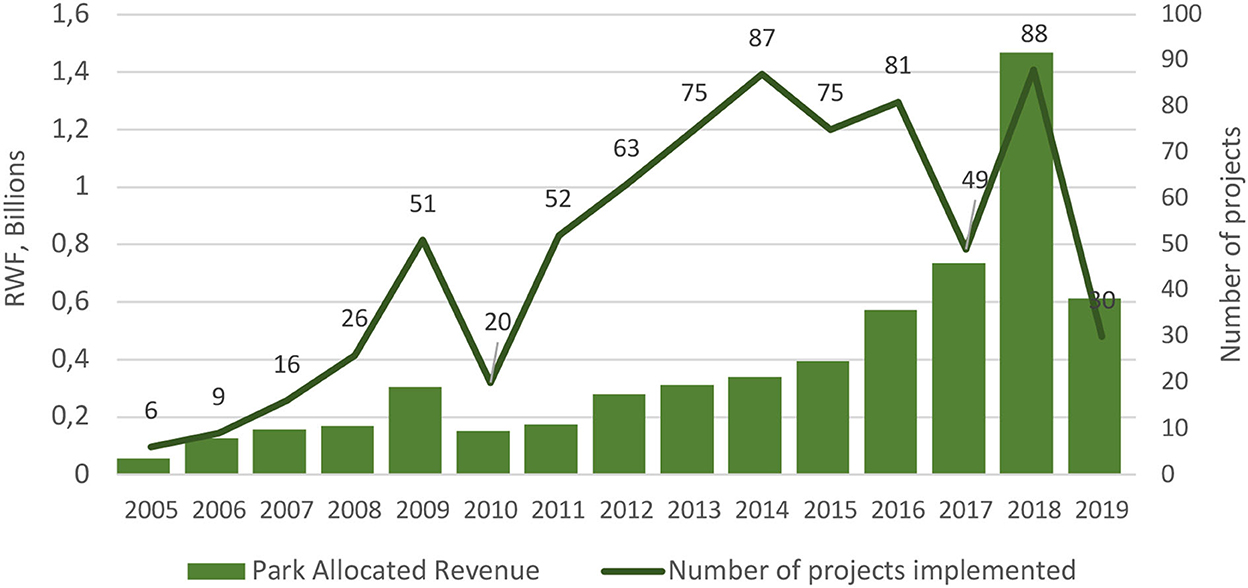
Figure 1 . Number of projects implemented through the TRSP per year from 2005 to 2019. RDB data, 2005–2019.
Projects funded by the TRSP fell into four major categories: infrastructure projects (80%); agriculture (15%); equipment purchase (2%); HWC (2%) and enterprise (1%).
Among the infrastructure projects, the largest allocation of funds went toward education projects (38% of all infrastructure projects), followed by housing (13%) and water supply (9%). The funded agricultural projects focused mostly on crop production and livestock (72% of all agricultural projects).
HWC support included mainly infrastructure support to prevent wildlife encroachment, such as a buffalo fence or a trench. The equipment purchase included items to support community development and livelihoods, such as milk and cassava processing plant equipment, sewing machines for local businesses, tannery equipment, carpentry equipment and transportation.
Desk review of prior studies
This study reviewed three prior assessments of Rwanda's TRSP [ International Gorilla Conservation Program (IGCP), 2007 ; Greater Virunga Transboundary Collaboration (GVTC), 2011 ; Volcanoes National Park et al., 2015 ] and notes from a TRSP project selection meeting held at Volcanoes National Park. The challenges highlighted in the prior studies were reviewed and compared to the findings in this study (see Table 2 ).
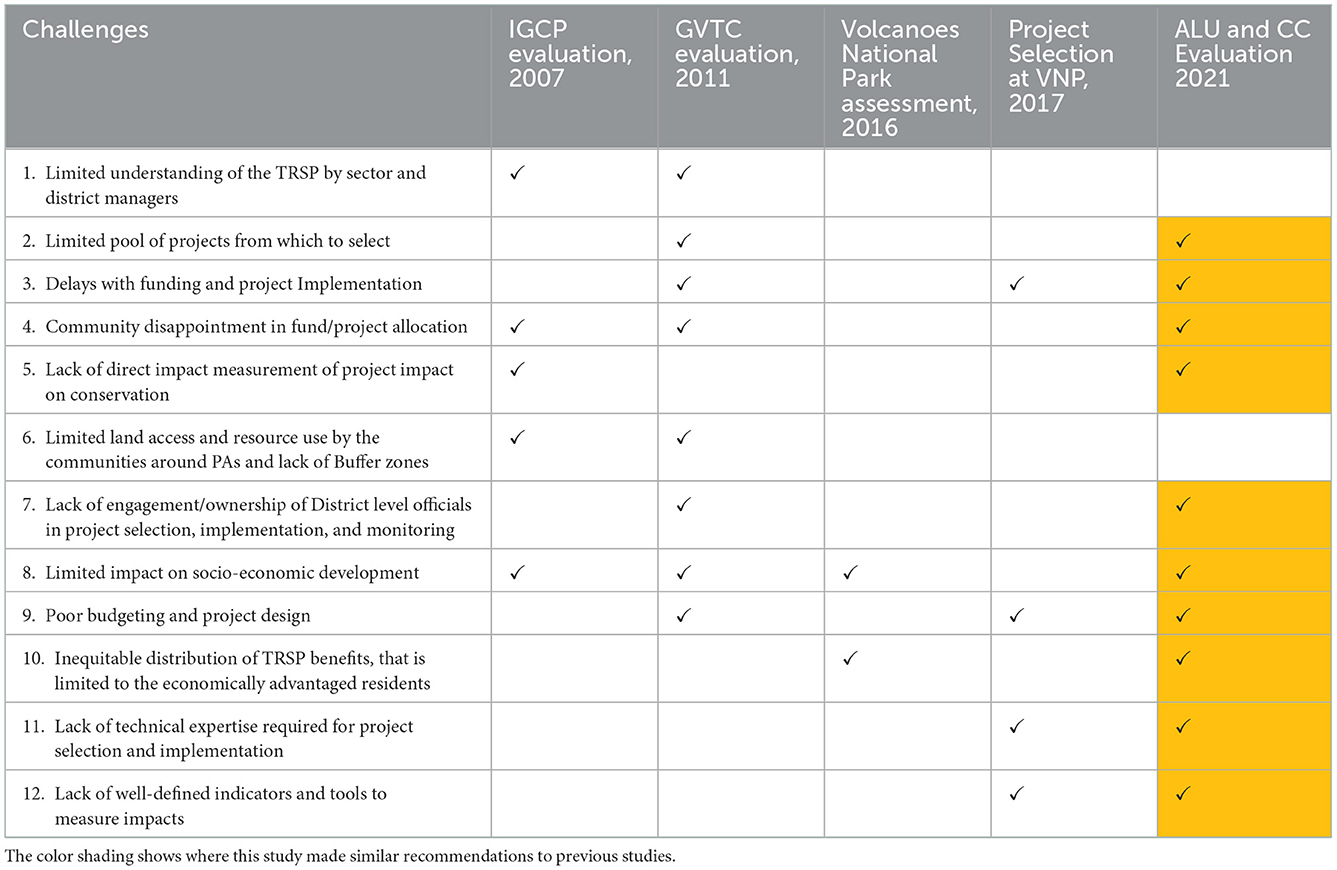
Table 2 . Challenges highlighted in this as well as prior studies on the TRSP.
RDB has implemented several measures to meet some of the challenges (e.g., development of a new TRS Policy in 2020), however the results of the current assessment showed that a number of the challenges identified in prior studies remain.
Community interview results
The community interview results are presented per NP, aggregated for all three NPs together, and then broken down between cooperative and non-cooperative members to provide a complete analysis of the different groups interviewed.
Demographic data
Table 3 shows the demographic information of participants in the field research, showing an average age of all those surveyed as 51.23 years, with 52% of respondents being male and 48% female. The main household income source for all participants was agriculture.
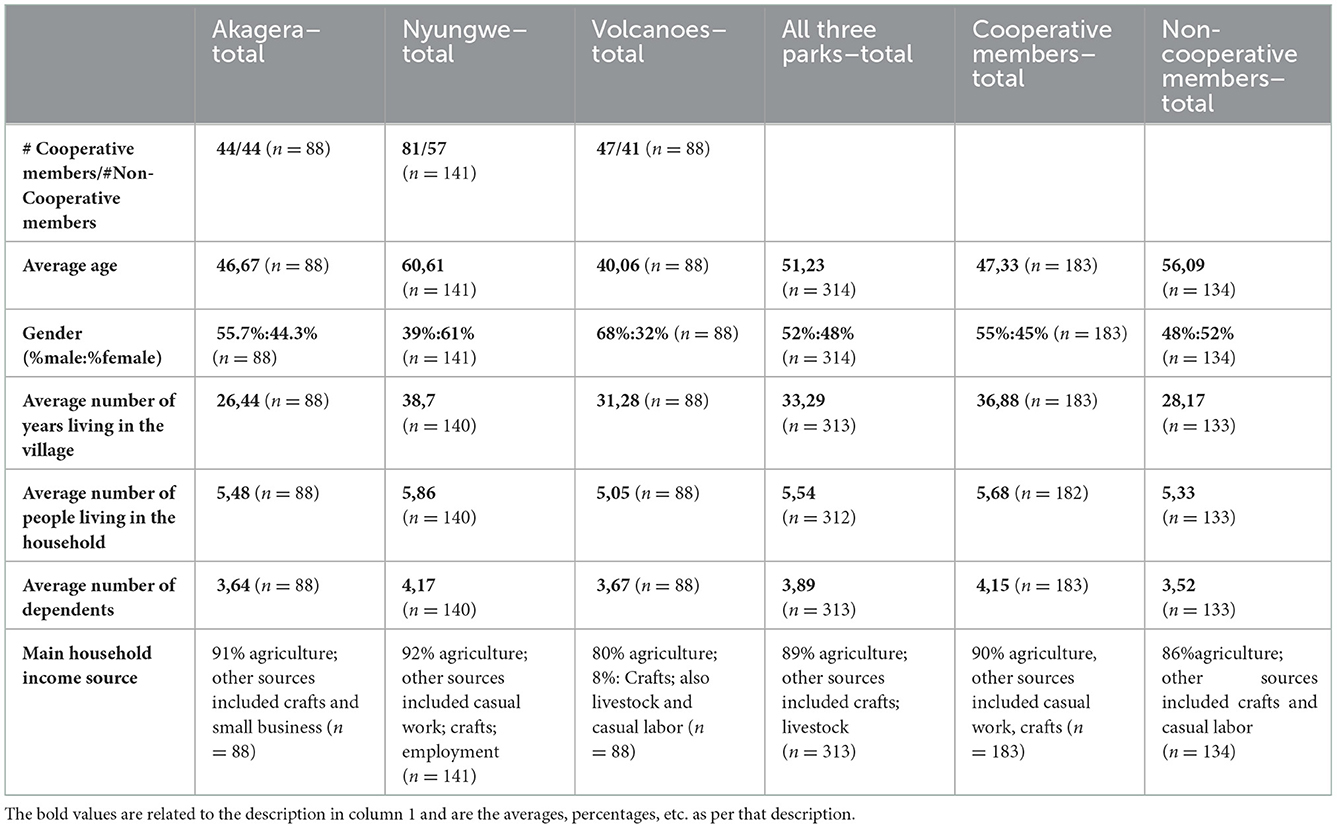
Table 3 . Demographic household data for the community surveys.
Awareness of TRSP
Table 4 presents results related to the awareness of the TRSP. As shown, an average of 74% of all respondents across the three NPs were aware of the TRSP, with Volcanoes National Park respondents having the highest awareness (83% of respondents had heard of the TRSP). This is likely because Volcanoes National Park, home to the mountain gorilla, has the largest number of international tourists with the highest revenues from gorilla permits and several visible TRSP projects conducted in the local community. The majority of participants (84%) said that they know where the revenue for the TRSP comes from, with cooperative members, in general, having greater awareness than non-cooperative members. When asked where the revenue comes from, some respondents said that it was from RDB rather than from tourism specifically, though the majority were aware of the connection to the NP and related tourism. Fifty-two percent of respondents said that their household had benefitted at some stage from the TRSP, with 74% of cooperative members saying they have benefitted while only 19% of non-cooperatives said so they had.
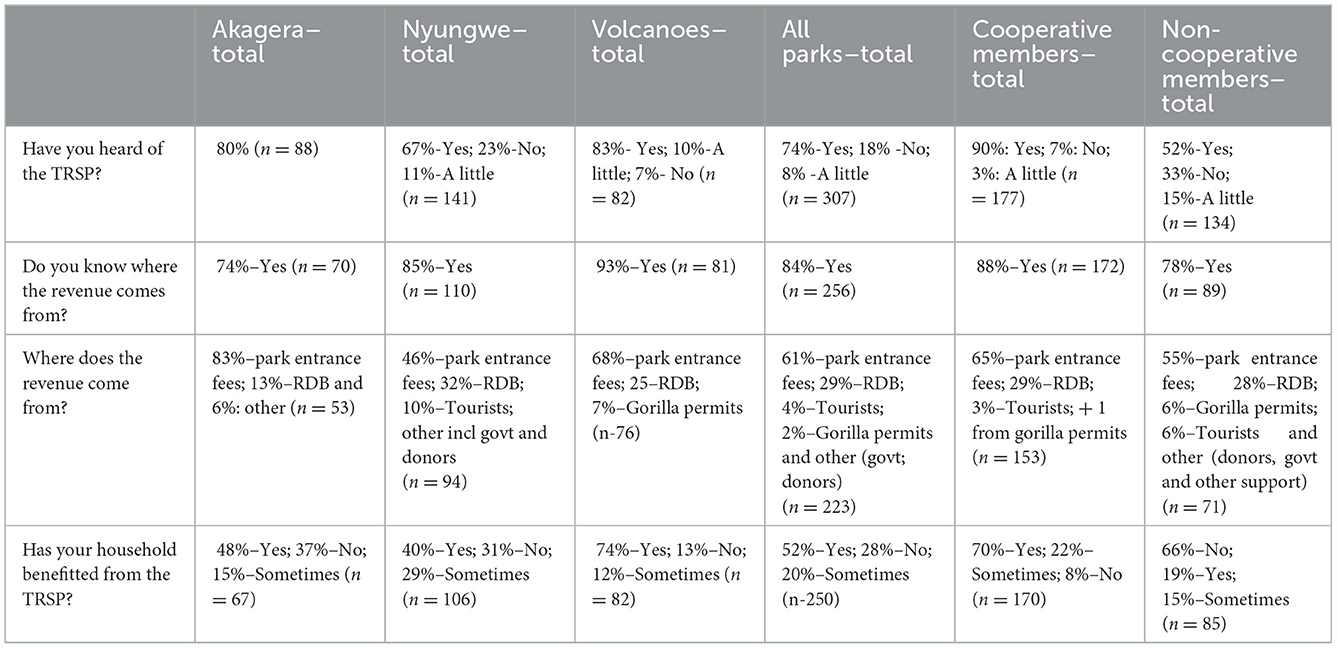
Table 4 . Community awareness of the TRSP.
Awareness of the project selection process
Fifty percent (50%) of the total respondents knew how TRSP projects were selected for funding, with Volcanoes National Park having the highest percentage (59%) ( Table 5 ). Forty five percent (45%) of community respondents said that the community were involved in the selection process, even among the cooperative respondents the percentage was less than half (47%).

Table 5 . Project selection process and implementation.
TRSP project assessment
Table 6 presents an overview of respondents' assessment of the projects implemented with the TRSP funds. Fifty eight percent of all respondents felt that the TRSP funds reach the people who need it the most, though only 32% of the non-cooperative respondents felt so, compared to 72% of cooperative members. In terms of expectations, 51% of all respondents felt that the TRSP meets their needs/expectations: 58% for cooperative members and 37% for non-cooperative members. Fifty six percent of all respondents felt that their quality of life had improved as a result of the TRSP, whereas 65% of cooperative members felt that their quality of life had improved and 39% for non-cooperative members.
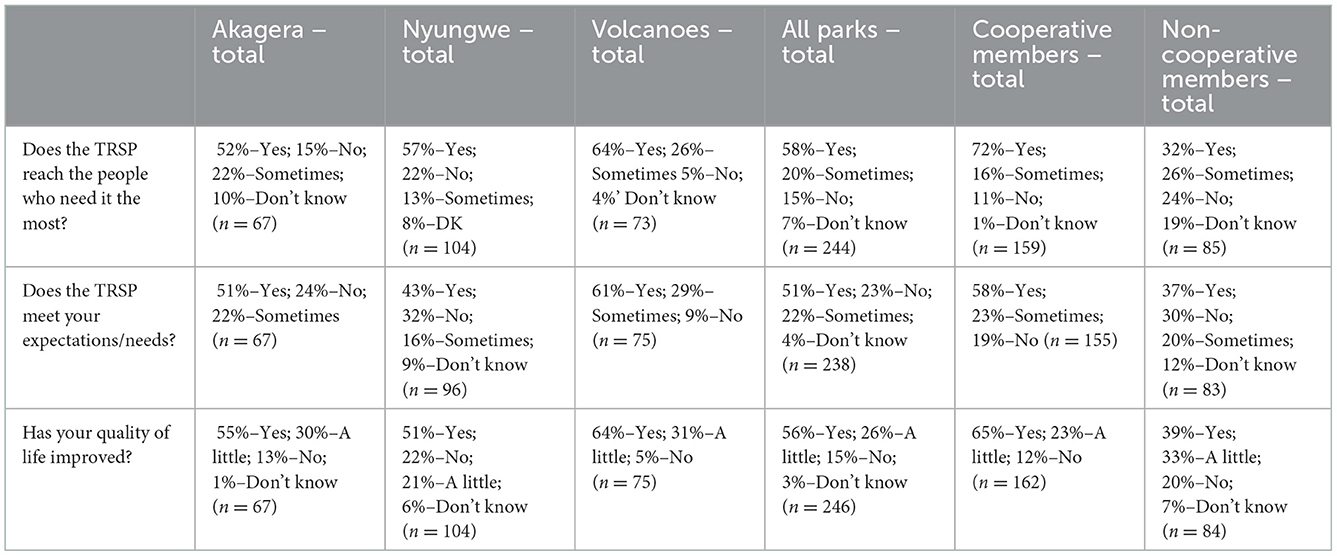
Table 6 . Tourism revenue sharing project assessment.
Satisfaction with the TRSP
Overall, 57% of respondents across all the NPs were satisfied with the TRSP; with 23% being very satisfied and 19% dissatisfied. Cooperative members (89%), who received the funds for projects, were generally more satisfied with the TRSP than non-cooperative members (63%). Overall, Nyungwe National Park had the highest number of participants who were satisfied (65%), followed by Volcanoes National Park (53%), then Akagera National Park (49%).
Eighty four percent of all community respondents felt that the TRSP has increased community support for conservation, while 95% of the respondents at Volcanoes National Park reported that it does.
Local leader interview results
The field research team also interviewed local leaders involved in the implementation of the TRSP to gain insights into their perspectives of the programme in terms of implementation and impacts on the livelihoods and attitudes of the local community.
Ninety five percent of the respondents were male (20 respondents in total, one female) and their roles in the TRSP were broken down as below, with the average number of years per respondent working in the TRSP being 7.16 years:
55%—Administration.
15%—Reviewer of proposals.
10%—Implementation of projects.
10%—Monitoring.
10%—Selection.
Respondents said that the main TRSP projects implemented were crop damage compensation and prevention measures and that the projects were developed by the cooperatives (68%), RDB (16%) and the community (11%). Given that the TRSP is different to the HWC fund, which supports crop damage compensation, it is clear that respondents were not aware of the difference, illustrating a lack of awareness of the objectives of the TRSP.
In terms of whether the TRSP projects have been developed on time, 32% said that they always were; 32% said sometimes; 21% frequently and 16% said that they were not developed on time. Forty seven percent of respondents said that the TRSP projects were developed as per the proposals/plans submitted, with 32% saying that they sometimes were and 16% saying that they frequently were. The main reasons indicated by respondents for projects not been developed according to the plan were a lack of financing and delayed financing.
Sixty one percent of respondents said that the community were always involved in the project selection process, while 22% and 11% reported being frequently or sometimes involved, respectively. Respondents who said that the community are involved said that they are involved mostly through choosing the project to submit and writing the proposal for the project, not in the decision-making in terms of project selection.
Sixty eight percent of respondents felt that the TRSP always reached the people who needed it the most, with 16% saying it frequently does, 16% saying it sometimes does and 11% saying that it does not. Seventy four percent of respondents said that information on the implementation process is communicated with the community. In terms of the TRSP projects corresponding to community needs/expectations: 55% of respondents said they do; 25% said that they sometimes do and 20% said that they do not. Eighty nine percent of respondents said that they think that the TRSP projects increase community support for conservation.
In terms of TRSP projects leveraging additional funding, 37% said that they sometimes do, 32% said that they do, 16% said that they do not and 16% said that they do not know. Respondents said that leveraged funding usually came from national (sometimes local) government and that it was mostly education projects, which leveraged additional funding, as well as conservation and HWC mitigation projects.
Fifty nine percent of respondents felt that the TRSP funding does not replace government funding, but 29% felt that it does and 12% did not know.
Respondents said the main successes of the TRSP are related to employment and infrastructure and the main challenges of the TRSP were that the proposals were not good enough; there were issues with implementation; there was a lack of connection to conservation; and the process for selecting projects wasn't always clear.
Overall, 53% of respondents were satisfied with the TRSP; 37% very satisfied and 11% dissatisfied.
Interview and online survey results
This section presents the results from the telephonic interviews and the online survey summarizing respondents' impressions of the TRSP in terms of conservation, their awareness of the TRSP and its achievements. In this section the term ‘respondents' collectively refers to to NGOs, private sector partners and government representatives unless otherwise specified.
TRSP impact on conservation
While it is difficult to attribute the direct impact of the TRSP on conservation, the survey results reveal that interviewed stakeholders recognized the role of the TRSP in conservation efforts. Eight out of 11 (73%) respondents indicated that the TRSP always, frequently or sometimes played a role in decreasing illegal activities, and nine out of 11 (82%) indicated that always, frequently or sometimes TRSP-supported projects increased community support for conservation.
TRSP awareness
Half of the respondents indicated that disadvantaged, women, and youth either did not benefit at all or occasionally benefited from the TRSP ( Figure 2 ).
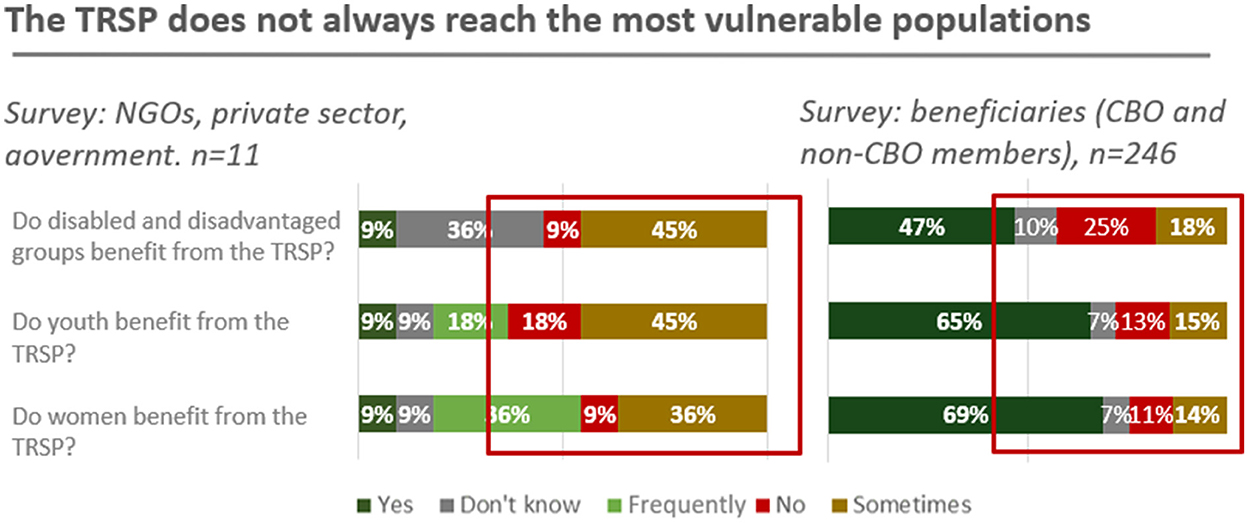
Figure 2 . Awareness of the TRSP. Survey NGO, private sector and government, n = 11.
TRSP achievements
Partner organizations viewed the main achievements of the TRSP to be infrastructure development, employment creation, and conservation support ( Figure 3 ).
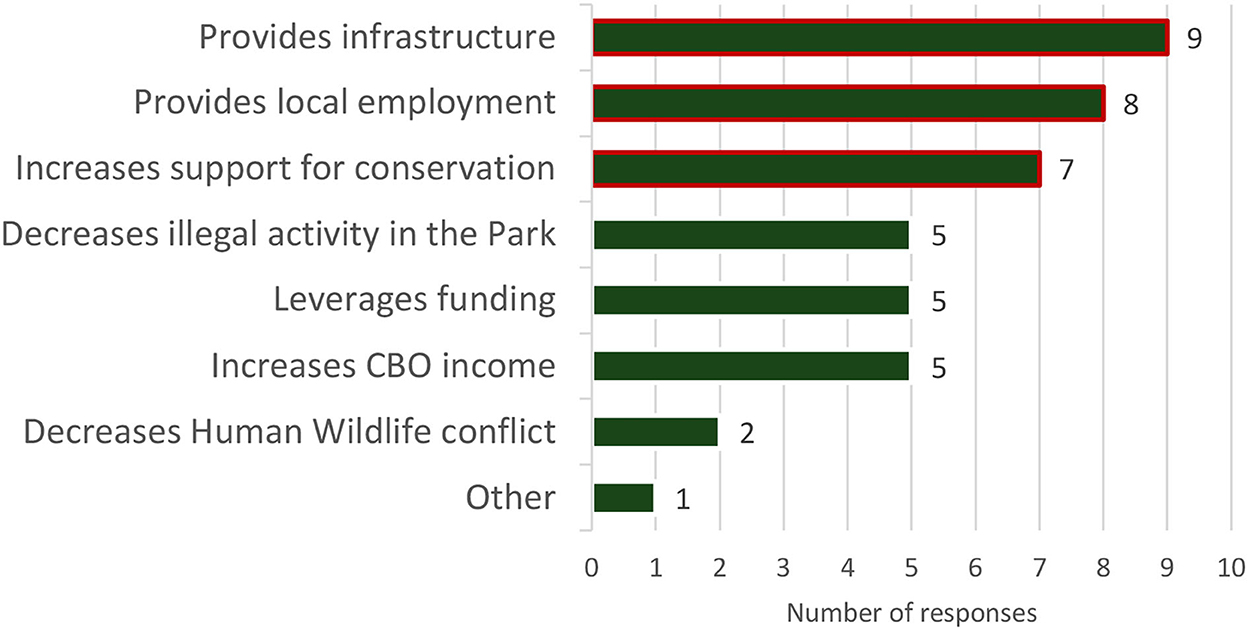
Figure 3 . Main successes of the TRSP as indicated by partner organizations.
Funding alignment with community needs
A majority (64%) of the respondents indicated that the TRSP sometimes meets community expectations and needs and 36% indicated that the programme frequently or always meets their needs.
TRSP challenges
A majority (73%) of the respondents indicated the top four challenges of the TRSP are: making the connection between the TRSP and conservation; implementation challenges; issues with the selection process; and proposals not being good enough ( Figure 4 ).
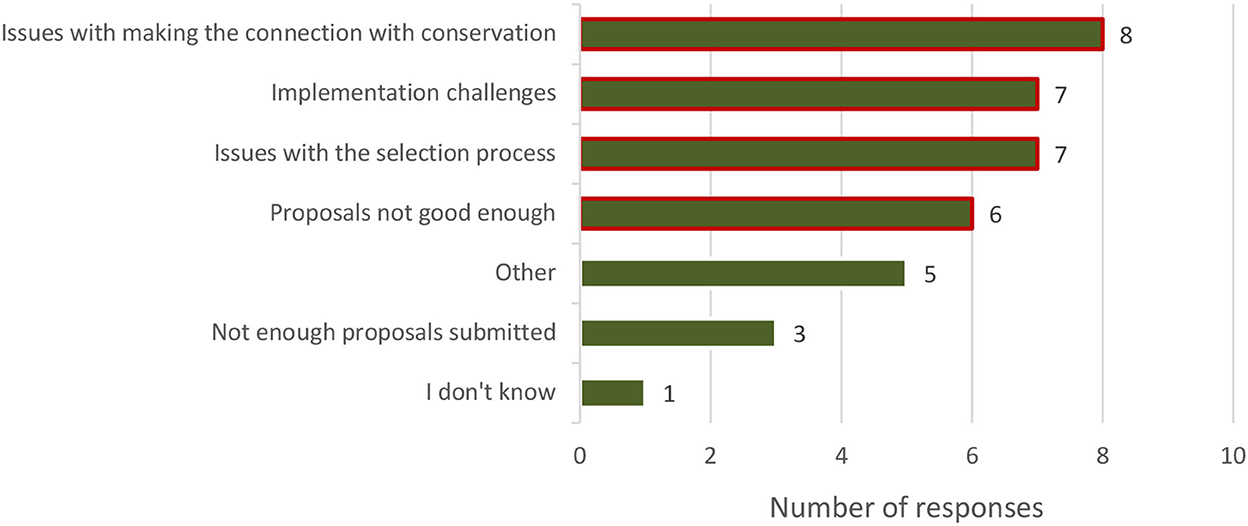
Figure 4 . The main challenges of the TRSP highlighted by partner organizations. Survey NGOs, private sector and government representatives, n = 11.
Community involvement
When asked about community involvement in the TRSP, 45% of respondents think that communities are either not involved at all or involved on an irregular basis in project selection, with many feeling that project selection is determined by the district office.
Project selection transparency
Respondents indicated that there is a lack of overall clarity on the project selection process. Nine percent of the respondents said there is sometimes clarity and 27% said there is no clarity on the process for selecting projects. This is markedly different to the response from the communities, where 65% of non-cooperative members indicated that the process is not clear; whereas 60% of cooperative members indicated that the process is clear.
Monitoring of the TRSP projects
When asked whether the TRSP-selected project implementation progress is regularly monitored, 27% of the respondents indicated no and 27% indicated they did not know.
Stakeholders surveyed and interviewed attributed community support for conservation to the TRSP and its related benefits and stated that the TRSP has developed infrastructure and created jobs. However, they indicate that overall, the TRSP is not meeting the needs of the community and in particular those of the marginalized community members and non-cooperative members, and that there are challenges with implementation and proposal development. In addition, they indicate that the communities are not fully involved in the whole TRSP process.
Only small differences existed between the community respondents and other stakeholders in their awareness of and satisfaction with the TRSP. Overall, the results highlight a general lack of awareness of how projects are selected and a perception that the community is not fully involved in the TRSP and that it is largely driven by the distrcit offices. This was similarly found by Tumusiime and Vedeld (2012) in their study on Uganda's TRSP where they found that there was no real local community participation. Interestingly, in our study partner organizations were less positive about the TRSP meeting community needs/expectations than the community members or the local leaders. More of the local leaders felt that the community were more involved in the selection process (61%) than the partner organization respondents (55%) and only 45% of the community respondents felt so. This indicates that the majority of the main target group—local communities—did not feel part of the selection process.
All groups, including 89% of the local leaders, 84% of community respondents, and 82% of the partner organizations, felt strongly that the TRSP has increased the community support for conservation. The overall percentage of local leader respondents who were satisfied with the TRSP (53%) is aligned with that of the community respondents (57%).
Many of the overall weaknesses identified by the various respondent groups have been previously identified in other studies [ International Gorilla Conservation Program (IGCP), 2007 ; Greater Virunga Transboundary Collaboration (GVTC), 2011 ], particularly in terms of challenges in implementation and the impact on socio-economic development. The recommendations below are based on the results of the primary and secondary research conducted for this study, which were further confirmed by prior assessments. There are several recommendations put forward to improve the overall impact of the TRSP in Rwanda and to ensure a greater understanding of the impacts through better monitoring and evaluation of projects and where and how funds are being spent.
Over the past 15 years, the results of this and previous studies ( Phiona and Jaya, 2015 ; Munanura et al., 2016 ) show that Rwanda's TRSP has met many of the programme's objectives, including creating support for conservation from local communities, generating awareness of conservation and the value of wildlife and PAs, building relationships between RDB and the communities, enhancing the lives of community members and developing infrastructure throughout the NP regions. Rwanda now has developed high quality infrastructure in the focal areas with strong support from local residents for conservation through the TRSP.
The main challenges identified in this study are effective community engagement, reaching the most vulnerable, and ensuring that the TRSP meets community needs. Having requested this study, the GoR is interested in adapting the TRS Policy to more effectively engage the communities living around the PAs in the TRSP and to allocate more funding to directly enhance the lives of Rwandan citizens living around PAs. We recommend that this can be done by involving communities more in the entire TRSP process, making the TRSP more accessible to all community members and allocating more funds to community development programmes proposed and selected by the communities themselves.
Based on the study's results, the following recommendations are made to enhance the TRSP and simultaneously support RDB's role as a leader in innovative community conservation. These recommendations can also be taken into consideration by other countries interested in developing and/or improving community engagement in, and benefits, from TRSPs.
i. Revise the revenue allocation model and eligibility to create resilience .
A majority of the TRSP revenue over the past 15 years has supported infrastructure development. A majority of the respondents consulted urged the GoR to rather allocate a majority of the TRSP revenue to livelihood development programmes. These programmes have the potential to enhance the resiliency of communities, create jobs, diversify revenue (reducing reliance directly on tourism, which is particularly important given the impacts of the COVID-19 pandemic) and to garner further conservation support from the communities.
It is recommended that the following percentages be used for the revenue allocation going forward: 70% for livelihood projects; 25% for infrastructure support; and 5% in an emergency fund. Equipment would fall under either livelihood projects or infrastructure support, depending on the project. HWC compensation is already covered by the HWC fund. The emergency fund would be used during times of crisis, such as COVID-19, when tourism revenue is severely impacted. The use of the funds would be guided by the updated TRS Policy and the funds should go into an interest-bearing account managed by RDB. Once the funds reach US$ 150,000 (RWF 1.5 million), the 5% should be allocated to livelihood projects. This amount was calculated by doubling the average annual spend of the TRSP, to ensure that the TRSP would have enough funds for 2 years in a time of crisis. Should there not be a suitable number of livelihood projects proposed by the community, the balance of the funds could be allocated to infrastructure projects. If community members propose a livelihood project that includes infrastructure, such as a shop, this should be included under livelihood projects and not infrastructure.
The TRSP is currently limited to providing funding to cooperatives. Stakeholders indicated that this excludes the most vulnerable community members, as most cooperatives require a membership fee. It is, therefore, recommended that the selection criteria should include individual groups, if projects benefit more than 10 households, as well as NGOs working with and selected by the communities. Inclusion of the most vulnerable community members is a target in the existing TRS Policy and is likely to remain a focus for the GoR in the revised policy.
It is also recommended that proposals for community capacity building (which are not currently permissible) should also be permissible (see recommendation five).
ii. Clarify and create awareness around the TRSP process .
There was a general lack of clarity about the TRSP cycle and process, from identification and selection of potential projects to monitoring and evaluation. Stakeholders indicated that the District Offices ultimately decide which projects are selected, not the communities. The current selection process includes three key steps: (1) communities develop project proposals; (2) the District Technical Committee screens and short lists the proposals; and (3) Park Revenue Sharing Committee (PRSC) selects the projects [ Rwanda Wildlife Authority (RWA), 2005 ]. The following are recommended:
a. Clarify the selection criteria used to select projects and make this public (and available in the local language) with clear definitions to avoid ambiguity and misinterpretation and to be accessible to to the entire population.
b. Develop and make accessible a programme schedule that makes it clear when proposals are due and when selection will take place. This should be the same every year to ensure consistency.
c. Publicize the list of the Park Revenue Sharing Committee members to create full transparency, accountability, and awareness.
d. Simplify the proposal submission procedure and adopt a two-step proposal process, which will make the application process more accessible and save time for the applicants as well as the reviewers:
• Step 1. Submission of a simple standard application form that is accessible to communities, which includes an option to request support for the full proposal if selected and if needed by the applicant; and
• Step 2. For those selected, a full proposal with standard template available, including a list of the required supporting documents.
e. A project awards ceremony would help launch projects and provide more visibility to the communities and relevant stakeholders on selected projects. This would also help create accountability for the project implementer.
iii. Enhance community involvement throughout the TRSP process .
It is recommended that the project selection process should be more inclusive of and engaging for local communities, who currently feel excluded from the process. The process should be initiated at the sector or cell level were projects would be deliberated by the community to determine collectively which proposals to submit; thus, ensuring community ownership for the decision. Communities should also be represented on the Park Revenue Sharing Committee; thus, part of the final vetting and selection process (see Figure 5 ). Decentralizing decision making and effectively engaging local communities in the process will build capacity as well as support for conservation.
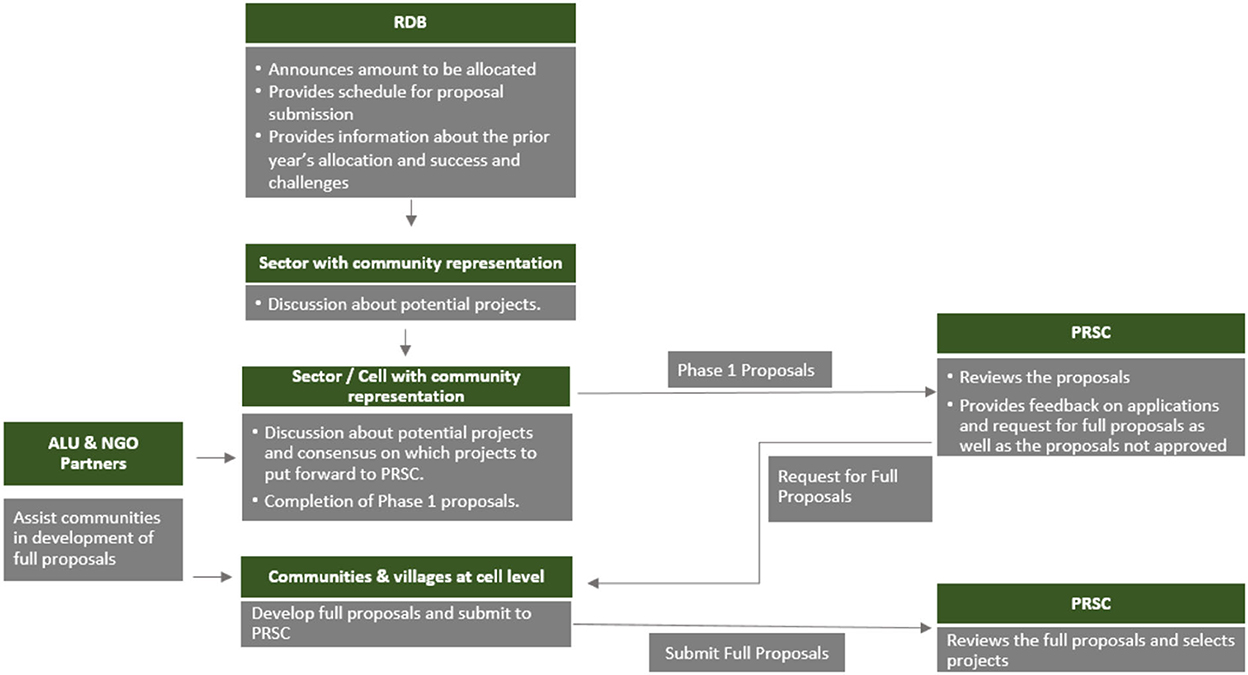
Figure 5 . Recommended TRSP project cycle.
iv. Enhance project execution .
Programme delays resulting from the flow of funding were reported as an issue for effectively and timeously implementing projects. The TRSP funding currently goes through the local government. To enhance efficiency, funding should be transferred directly to the implementing organizations and when needed, NGOs selected by the community, can serve as fiscal agents until capacity is developed.
Implementation can be done, if needed, by an NGO or the private sector (selected by the community) that has the required skills and expertise, and part of the process can be to build the capacity of the community organization.
v. Support capacity for communities, local government and RDB .
Lack of capacity and skills were identified in the qualitative comments as one of the major barriers for community participation, programme management and project implementation. Capacity building should be embedded into the entire TRSP process from supporting communities in the application process to project implementation and monitoring. NGOs and private sector partners operating in all the NP landscapes can help provide capacity support and help with implementation, which will help leverage other programmes in the area. In some cases, capacity building is needed for local government and staff working on the TRSP as well. The TRSP could be used to finance these capacity support programmes.
vi. Enhance monitoring and evaluation .
The capturing of data and information to better inform the TRSP, support adaptive management, and guide other PA revenue-sharing programmes in Africa and around the world is critical. While project verification procedures are stipulated in the TRS Policy, this is rarely followed due to a lack of capacity, and there is an overall lack of clarity on, and understanding of, the monitoring process among partner organizations and a lack of capacity for monitoring and evaluation (M&E). As a result, the following are recommended:
• At a minimum, there should be recruitment of one monitoring and evaluation senior officer fully dedicated to reviewing, monitoring, and reporting on the TRSP. This position could be financed through the TRSP.
• While ultimate responsibility and accountability rests with the monitoring and evaluation senior officer, he/she should develop a system for monitoring as well as relevant tools and should train and engage stakeholders in monitoring and evaluation. Monitoring smart phone platforms that community members can use for project planning, execution and monitoring could also be considered.
The aim of these recommendations is to ensure greater direct community involvement and overall stakeholder awareness and understanding of the TRSP as well as a greater connection between local communities to conservation resulting in greater support for conservation, pride in Rwanda's natural areas and improved livelihoods. In addition, with greater coordination with communities, private sector and NGOs, the TRSP can be used to leverage other funding and to use existing resources more efficiently.
Rwanda has one of the highest revenue sharing programmes, in terms of percentage revenue allocated to the programme, in Africa. Over the past 15 years, the TRSP has financed infrastructure, supported community livelihoods, and established a positive linkage to, and support for, conservation. Despite the TRSP having achieved positive results, various reviews have highlighted challenges with the programme. It was found in the secondary research for this study that many of the past recommendations to improve the TRSP have not been implemented and several of the same challenges exist. It is likely that this is due to the complexity of implementing many of the recommendations due to the diversity of stakeholders involved, lack of capacity within the government to implement recommendations, and the size of the beneficiary population. Although this study attempted to engage with as many relevant stakeholders as possible, due to the COVID-19 pandemic, there were some limitations with access and in-person meetings.
Ultimately, given the vision of the TRSP (community support, conservation linkages, and relationship building with RDB), changes are recommended to ensure that the community are directly engaged in the TRSP, benefitting from it and seeing the linkages between it and the related conservation. A number of the challenges faced by the Rwanda TRSP are similarly faced by other country TRSPs, highlighting that tourism-revenue sharing is complex, with a diversity of stakeholders and dependent on an industry that has also been shown to be volatile and vulnerable to shocks. The recommendations in this study have, therefore, also sought to build greater resilience in the TRSP and to reduce long-term risks. The commissioning of this study by the GoR demonstrates a keen interest in understanding the challenges and how to improve the TRSP, which is a critical first step. Incorporating communities into the entire TRSP process, allocating more revenue to community livelihoods than infrastructure projects, embedding capacity building into the programme and supporting monitoring and evaluation will further enhance the TRSP and help achieve its goals, which will support Rwanda's ambitious conservation and community goals.
As Gishwati-Mukura National Park was only added to the TRSP in 2019, it was not included in the field research as it will take time for the impacts of the TRSP to be felt. It is, therefore, recommended that baseline field research be conducted around Gishwati-Mukura National Park as soon as possible to measure the impacts of the TRSP more accurately over time. This will provide an opportunity to directly assess the impact of the TRSP before and after funds have been distributed. More detailed research on poverty level indicators should also be included in annual monitoring of the TRSP in order to have updated, robust data on impacts, rather than focusing on outputs and outcomes of the TRSP.
Data availability statement
The datasets presented in this article are not readily available because the data was collected for the government of Rwanda, so we would need to get their permission to share if requested. Requests to access the datasets should be directed to SS, ssnyman@alueducation.com .
Ethics statement
Ethical review and approval was not required for the study on human participants in accordance with the local legislation and institutional requirements. The patients/participants provided their written informed consent to participate in this study.
Author contributions
SS and KF conceived and designed the analysis, collected the data, contributed data or analysis tools, performed the analysis, and wrote the paper. AB collected the data, contributed data or analysis tools, and performed the analysis. BM and TN conceived and designed the analysis and provided logistical support. All authors contributed to the article and approved the submitted version.
Funding for this research was received from the International Gorilla Conservation Program (IGCP).
Acknowledgments
Thank you to the International Gorilla Conservation Program (IGCP) for funding this research and to the Rwanda Development Board for their support with collating documents and identifying stakeholders. Thank you to all the public, private, NGO and community participants who engaged in the surveys and consultations and also to the ALU SOWC students who conducted the community interviews around the three national parks.
Conflict of interest
The authors declare that the research was conducted in the absence of any commercial or financial relationships that could be construed as a potential conflict of interest.
Publisher's note
All claims expressed in this article are solely those of the authors and do not necessarily represent those of their affiliated organizations, or those of the publisher, the editors and the reviewers. Any product that may be evaluated in this article, or claim that may be made by its manufacturer, is not guaranteed or endorsed by the publisher.
1. ^ As of 27 April 2022 exchange rate. https://www1.oanda.com/ .
2. ^ Gishwati-Mukura was integrated into the TRSP in 2019.
Ahebwa, W. M., van der Duim, R., Sandbrook, C. (2012). Tourism revenue sharing policy at Bwindi Impenetrable National Park, Uganda: A policy arrangements approach. J. Sustain. Tour. 20, 377–394. doi: 10.1080/09669582.2011.622768
CrossRef Full Text | Google Scholar
Dewu, S., Røskaft, E. (2018). Community attitudes towards protected areas: Insights from Ghana. Oryx 52, 489–496. doi: 10.1017/S0030605316001101
Franks, P., Twinamatsiko, M. (2017). Lessons Learnt from 20 Years of Revenue Sharing at Bwindi Impenetrable . IIED report. Available online at: http://pubs.iied.org/17612IIED
Google Scholar
Government of Rwanda (GoR). (2016). ‘Law No45/2015 OF 15/10/2015 Establishing the Gishwati-Mukura national park', Official Gazette n° 05 of 01/02/2016, 104-108 . Government of Rwanda (GoR) 2016 - Rwanda Development Board, Kigali, Rwanda.
Greater Virunga Transboundary Collaboration (GVTC). (2011). Assessment of the Performance of the Revenue Sharing Programme During 2005-2010. Greater Virunga Transboundary Collaboration (GVTC), Kigali, Rwanda.
Imanishimwe, A., Niyonzima, T., Nsabimana, D. (2019). Comparing the community dependence on natural resources in Nyungwe National Park and the contribution of revenue sharing through integrated conservation and development projects. Afr. J. Online 2. doi: 10.4314/rjeste.v2i1.9
International Gorilla Conservation Program (IGCP). (2007). Evaluation des projets financés par les revenus issus du tourisme . International Gorilla Conservation Programme, Kigali, Rwanda
Kaaya, E., Chapman, M. (2017). Micro-credit and community wildlife management: complementary strategies to improve conservation outcomes in Serengeti National Park, Tanzania. Environ. Manage. 60, 464–475. doi: 10.1007/s00267-017-0856-x
PubMed Abstract | CrossRef Full Text | Google Scholar
Kambagira, A. (2019). Tourism resource distribution and development in Uganda. A case of Bwindi Impenetrable National Park (Ph. D. dissertation). Makerere University, Kampala, Uganda.
Kihima, B. O., Musila, P. M. (2019). Extent of community participation in tourism development in conservation areas: A case study of Mwaluganje Conservancy. Parks 25, 47–56. doi: 10.2305/IUCN.CH.2019.PARKS-25-2BOK.en
Lindsey, P., Allan, J., Brehony, P., Dickman, A., Robson, A., Begg, C., et al. (2020). Conserving Africa's wildlife and wildlands through the COVID-19 crisis and beyond. Nat. Ecol. Evol. 4, 1300–1310. doi: 10.1038/s41559-020-1275-6
Mananura, I. E., Sabuhuro, E. (2020). “The potential of tourism revenue sharing policy to benefit conservation in Rwanda,” in Routledge Handbook of Tourism in Africa . London, United Kingdom: Routledge.
Munanura, I. E., Backman, K. F., Hallo, J. C., Powell, R. B. (2016). Perceptions of tourism revenue sharing impacts on volcanoes national park, rwanda: a sustainable livelihoods framework. J. Sustain. Tour. 24, 1709–1726. doi: 10.1080/09669582.2016.1145228
Phiona, K., Jaya, N. E. (2015). The effectiveness of rwanda development board tourism revenue sharing program towards local community socioeconomic development: a case study of Nyungwe National Park. Eur. J. Hospital. Tour. Res. 3, 47–63. Available online at: http://www.eajournals.org/wp-content/uploads/The-effectiveness-of-Rwanda-Development-Board-tourism-revenue-sharing-program-towards-local-community-socio-economic-development.pdf
Republic of Rwanda (2018). Ministry of Trade and Industry, National Policy on Cooperatives in Rwanda: “Toward Private Cooperative Enterprises and Business Entities for Socio-Economic Transformation” . Available online at: http://extwprlegs1.fao.org/docs/pdf/rwa193693.pdf (accessed on September 2, 2021).
Rwanda Development Board (RDB). (2017a). Increase of Gorilla Permit Tariffs | Official Rwanda Development Board (RDB) Website . Rwanda Development Board, Kigali, Rwanda. Available online at: https://rdb.rw/increase-of-gorilla-permit-tariffs/ (accessed on December 2, 2020).
Rwanda Development Board (RDB). (2020). Tourism Revenue Sharing in Rwanda: Policy and Guidelines. Rwanda Development Board, Kigali, Rwanda.
Rwanda Development Board (RDB). (2016). Revenue Sharing 2016–2017: Projects' Selection Report . Musanze.
Rwanda Development Board (RDB). (2017b). Revenue Sharing 2017–2018: Projects' Selection Report . Musanze.
Rwanda Wildlife Authority (RWA). (2005). Tourism Revenue Sharing in Rwanda-Provisional Policy and Guidelines. Office Rwandais du Tourisme et des Parcs Nationaux, Kigali, Rwanda.
Rwanda: Division in Sectors (2017). Available at https://www.citypopulation.de/en/rwanda/sector/admin/ (accessed on January 14, 2021).
Snyman, S., Bricker, K. S. (2019). Living on the edge: benefit sharing from protected area tourism. J. Sustain. Tour. 27, 705–719. doi: 10.1080/09669582.2019.1615496
Snyman, S., Spenceley, A. (2019). Private Sector Tourism in Conservation Areas in Africa. Wallingford, Oxfordshire: CABI, Oxford.
Spenceley, A. (2014). Tourism Concession Guidelines for Transfrontier Conservation Areas in SADC . Report to GIZ/SADC. Retrieved from https://tfcaportal.org/sites/default/files/public-docs/tourism_concession_guidelines_sadc_tfcas_final.pdf (accessed on May 12, 2020).
Spenceley, A., Snyman, S., Rylance, A. (2017). Revenue sharing from tourism in terrestrial African protected areas. J. Sustain. Tour. 27, 1–15. doi: 10.1080/09669582.2017.1401632
Störmer, N., Weaver, L. C., Stuart-Hill, G., Diggle, R. W., Naidoo, R. (2019). Investigating the effects of community-based conservation on attitudes towards wildlife in Namibia. Biol. Conserv. 233, 193–200. doi: 10.1016/j.biocon.2019.02.033
Tumusiime, D. M., Vedeld, P. (2012). False Promise or false premise? Using tourism revenue sharing to promote conservation and poverty reduction in Uganda. Conserv. Soc. 10, 15–28. doi: 10.4103/0972-4923.92189
Twinamatsiko, M., Baker, J., Franks, P., Infield, M., Olsthoorn, F., Roe, D. (2018). An Overview of Integrated Conservation and Development in Uganda. London, United Kingdom: Routledge. Available online at: https://www.google.com/search?q=London&stick=H4sIAAAAAAAAAOPgE-LUz9U3ME4xzStW4gAxTbIKcrRUs5Ot9POL0hPzMqsSSzLz81A4Vmn5pXkpqSmLWNl88vNS8vN2sDLuYmfiYAAALM0efE8AAAA&sa=X&ved=2ahUKEwiQ6O_0por8AhWVnnIEHYSyAxEQmxMoAHoECGEQAg
Volcanoes National Park Rwanda Development Board, and Janvier, K. (2015). Revenue Sharing Projects-Selection, Exercise 2015: The Minutes of the Workshop . Rwanda Development Board, Kigali, Rwanda.
Walpole, M. J., Thouless, C. R. (2005). “Increasing the value of wildlife through non-consumptive use? Deconstructing the myths of ecotourism and community-based tourism in the tropics” in People and Wildlife: Conflict or Coexistence? , eds. R. Woodroffe, S. Thirgood, A. Rabinowitz (2005). Cambridge, UK: Cambridge University Press, 122–139.
Wunder, S. (2000). Ecotourism and economic incentives—an empirical approach. Ecol. Econ. 32, 465–479. doi: 10.1016/S0921-8009(99)00119-6
Ziegler, J., Araujo, G., Labaja, J., Snow, S., King, J. N., Ponzo, A., et al. (2020). Can ecotourism change community attitudes toards conservation? Oryx 55, 546–555. doi: 10.1017/S0030605319000607
Keywords: tourism, protected areas, revenue-sharing, conservation, development, Rwanda, local communities
Citation: Snyman S, Fitzgerald K, Bakteeva A, Ngoga T and Mugabukomeye B (2023) Benefit-sharing from protected area tourism: A 15-year review of the Rwanda tourism revenue sharing programme. Front. Sustain. Tour. 1:1052052. doi: 10.3389/frsut.2022.1052052
Received: 23 September 2022; Accepted: 19 December 2022; Published: 03 February 2023.
Reviewed by:
Copyright © 2023 Snyman, Fitzgerald, Bakteeva, Ngoga and Mugabukomeye. This is an open-access article distributed under the terms of the Creative Commons Attribution License (CC BY) . The use, distribution or reproduction in other forums is permitted, provided the original author(s) and the copyright owner(s) are credited and that the original publication in this journal is cited, in accordance with accepted academic practice. No use, distribution or reproduction is permitted which does not comply with these terms.
† These authors have contributed equally to this work
This article is part of the Research Topic
Ecotourism Models: Identifying Contributions to Conservation and Community
Navigating the Balance Between Revenue Generation and Conservation at a Cham Living Sacred Heritage Site: Priestly Views and Challenges
- Open Access
- First Online: 13 October 2023
Cite this chapter
You have full access to this open access chapter

- Quang Dai Tuyen 4
Part of the book series: Global Vietnam: Across Time, Space and Community ((GVATSC))
783 Accesses
Tourism Benefit-Sharing (TBS) has gained significant attention in the past two decades as a means of providing economic opportunities and preserving natural protected areas (PAs) and cultural heritage sites globally.
You have full access to this open access chapter, Download chapter PDF
Introduction
Tourism Benefit-Sharing (TBS) has gained significant attention in the past two decades as a means of providing economic opportunities and preserving natural protected areas (PAs) and cultural heritage sites globally (Akbar & Yang, 2021 ; Xu et al., 2009 ). TBS fosters relationships between local communities and authorities, providing an important factor in creating sustainable destinations and contributing to the 17 SDGs (Carius & Job, 2019 ; Imanishimwe et al., 2018 ). Effective benefit-sharing, as described in this study, involves local authorities fairly distributing the economic benefits from tourism revenue to Indigenous communities, which enhances their social and economic environment and encourages mutual relationships (Balmford et al., 2009 ).
Revenue generated from tourism development of PAs has the potential to provide economic benefits, introduce local culture, promote economic diversification, improve the quality of social services, and enhance local infrastructure (Melita & Mendlinger, 2013 ; Tumusiime & Vedeld, 2012 ). However, despite extensive research on TBS, debates on the most effective forms of PA conservation persist (Archabald & Naughton-Treves, 2001 ; Queiros & Mearns, 2019 ; Spenceley et al., 2017 ). Local communities play a crucial role in identifying and evaluating the value of TBS, despite varying stakeholder perceptions (Tumusiime & Vedeld, 2012 ). Hence, there is a pressing need for win–win TBS policies that maintain the sustainable development of PAs (Benjaminsen & Svarstad, 2010 ; Mukanjari et al., 2013 ; Spenceley et al., 2017 ; Tumusiime & Vedeld, 2012 ).
TBS has been widely studied in the context of national parks around the world (Makame & Boon, 2017 ; Munanura et al., 2016 ), but less research has focused on TBS at cultural heritage sites, particularly living heritage sites, which play a crucial role in preserving the cultural heritage of Indigenous communities. Literature suggests that TBS is an important way to explore the economic impacts of tourism on local communities (Mbaiwa & Stronza, 2010 ; Xu et al., 2009 ). However, most studies have been conducted in African countries, leaving other regions, such as Southeast Asian countries, largely overlooked. This research fills this gap by focusing on TBS in the context of ethnic and cultural heritage in Vietnam.
Studies on TBS have investigated perspectives of various stakeholders, including authorities, PA management boards, and local communities (Bruyere et al., 2009 ; Carius & Job, 2019 ; MacKenzie, 2012 ; Weisse & Ross, 2017 ). However, in-depth studies on different target groups within the local community, especially those engaged in conservation of living heritage, seem to be scarce. Moreover, previous studies have emphasized tourism revenue allocation but have not clarified the distribution of tourism revenue among host communities and who in the community should receive it (Mbaiwa & Stronza, 2010 ; Snyman & Bricker, 2019 ). In the Vietnamese context, there have been studies on the living heritage of the Kinh majority group, such as Huong Pham’s ( 2015 ) examination of the economic impact of tourism on local people in Hoi An Ancient Town. However, the living heritage of minority communities has not received the same level of attention.
Tourism plays a significant role in driving Vietnam’s transformation into a developed nation (Saltiel, 2014 ). One of the key components of this growth is the promotion and preservation of ethnic minority heritage, which attracts a significant number of tourists to the country (Lask & Herold, 2004 ; Salemink, 2013 ; Saltiel, 2014 ; Truong, 2013 ). The government of Vietnam has recognized the importance of ethnic minority heritage and has issued several policies and guidelines aimed at promoting socio-cultural and social development for ethnic minorities, including the Cham people of Ninh Thuận (Lask & Herold, 2004 ). The preservation of the Cham cultural heritage is crucial not only for the promotion of tourism but also for the overall development of the country and its people.
As the focus of this study, the Cham people in Ninh Thuận boast an abundant cultural heritage, including over 70 festivals and ceremonies that are still performed annually with the participation of the Cham community and guidance from religious dignitaries (Sakaya, 2003 ). The Cham’s traditional approaches to the stewardship of sacred sites have been officially recognized and promoted by the government since 2012, with representatives from the Ahier Cham community serving as consultants on cultural and religious issues concerning the Cham community.
This rich cultural heritage, particularly the temple-tower architecture system found throughout the Central region and in Ninh Thuận Province, has become a major tourist attraction and product in Vietnam. In 2019, Ninh Thuận welcomed 2.35 million visitors, a 7.3% increase from the previous year, with 100,000 being international arrivals (an annual increase of 25%) and 2.25 million being domestic arrivals (an annual increase of 6.6%) (Sở VH-TT-DL, 2020 ).
While the rise in tourism has brought positive economic benefits to the region, it has also led to concerns over the allocation of economic benefits from the Cham cultural heritage sites and the satisfaction of the Cham people as the owners and guardians of this cultural heritage. This chapter seeks to address these concerns by exploring the challenges faced by Cham dignitaries in maintaining their cultural heritage through TBS, and examining their perspectives on TBS and its impact on their cultural heritage. This study aims to contribute to the understanding of how equitable TBS can be developed at a living heritage site, where the financial benefits from the commodification of minority culture can be used to support local communities and the custodians of Indigenous heritage.
The contribution of this research is substantial in several key aspects. Firstly, it brings to light the difficulties faced by Cham dignitaries in safeguarding the cultural heritage of the Cham community in Ninh Thuận. Secondly, it explores the views of the Cham dignitaries on TBS and its impact on their cultural heritage. Additionally, it provides an in-depth understanding of the distribution of economic benefits from Cham cultural heritage sites and the satisfaction of the Cham community with TBS. Furthermore, this research contributes to the broader knowledge base on the significance of TBS in the preservation and promotion of cultural heritage. The findings can serve as a useful reference for policymakers and practitioners when developing equitable TBS programs, especially in the context of living heritage sites. The study emphasizes the importance of inclusive and culturally appropriate TBS programs that prioritize the involvement and benefit of local communities, including Indigenous people, by taking into account the challenges faced by the Cham dignitaries and their perspectives. Furthermore, the insights gained from this study can also inform the creation of sustainable and socially responsible cultural tourism programs. By highlighting the challenges faced by the Cham dignitaries, this research can steer future research in the field of cultural heritage preservation and promote best practices for equitable TBS. Overall, this study provides valuable insights into the challenges and opportunities faced by the Cham community in preserving their cultural heritage and the role of TBS in supporting these efforts.
Traditional Custodianship and Cultural Heritage Preservation
The preservation of cultural heritage has been a topic of great concern in the contemporary era. Western heritage management practices have widely impacted many nations, and although these approaches have had a significant impact, they have often neglected the vital role that traditional custodianship systems play in protecting and preserving a community’s heritage in the long term. Despite the recognition of the crucial role that traditional custodianship systems play in heritage management, these systems have often been overlooked in regions such as Asia and Africa (Chirikure et al., 2010 ; Ndoro & Wijesuriya, 2015 ).
However, this perspective has been challenged by several case studies in Africa that demonstrate the significance of traditional custodianship systems in heritage management (Abungu, 2015 ; Waterton, 2010 ). These studies highlight the importance of incorporating traditional management systems into the management of cultural heritage and have been recognized by UNESCO ( 2013 ) as a key component in the management of cultural heritage.
Unfortunately, some researchers have found that there is a lack of consultation with local communities in the management of cultural heritage in Africa in practice, as these communities are not considered to be conservation experts (Abungu, 2015 ; Waterton, 2010 ). This overlooks the vital role that traditional custodianship systems play in protecting and managing cultural heritage over the long term (Chirikure et al., 2010 ; Ndoro & Wijesuriya, 2015 ). However, there is a growing recognition of the significance of traditional custodianship systems in managing cultural heritage, and their role is increasingly being acknowledged and integrated into heritage management practices (Abungu, 2015 ; UNESCO, 2013 ).
To effectively preserve cultural heritage, it is crucial to recognize the value of traditional custodianship systems and to involve local communities in the management and protection of their cultural heritage (Chirikure et al., 2010 ; Ndoro & Wijesuriya, 2015 ). By doing so, we can ensure that cultural heritage is not only preserved, but also sustained and passed down from generation to generation (Abungu, 2015 ; UNESCO, 2013 ). The integration of traditional management systems into heritage management practices will also ensure that the heritage reflects the values and traditions of the local communities and that their voices are heard in the decision-making process (Weise, 2013 ). In short, the recognition of the importance of traditional custodianship systems and the involvement of local communities in the management of cultural heritage are critical components in ensuring the preservation and sustainability of cultural heritage (Abungu, 2015 ; Chirikure et al., 2010 ; Ndoro & Wijesuriya, 2015 ; UNESCO, 2013 ; Weise, 2013 ).
Traditional custodianship systems play a key role in the preservation and management of cultural heritage within communities. These systems are often rooted in customary laws that govern the use of sacred sites and protect them from violations (Abungu & Githitho, 2012 ; Harris, 1991 ; Shen et al., 2012 ). The regulations and principles established by these traditional systems help to minimize negative impacts on heritage sites and are a significant aspect of the local community’s connection to the landscape and its resources (Smith & Turk, 2013 ). However, the significance of traditional custodianship systems is often disregarded in heritage conservation and development, leading to the creation of a form of heritage that goes against local views and traditions, thereby reducing the cultural significance of the heritage being preserved (Byrne, 2012 ). This is due in part to the fact that these systems are often overlooked in heritage management practices (Bwasiri, 2011 ).
To address this issue, scholars have recommended integrating local customary systems within Western conservation models as the most effective approach to cultural heritage management (Bwasiri, 2011 ; Smith & Turk, 2013 ). This approach enables the exploration of the social concerns and needs of the local community, which is a crucial consideration, particularly in the case of the Cham community studied in this research. By considering the perspectives and needs of the Cham community, the government can effectively manage the Cham temples for the benefit of the Cham people, while preserving the cultural heritage and its traditional values.
The preservation of cultural heritage requires a holistic approach that takes into account the perspectives and needs of the local community who are connected to the heritage site (Weise, 2013 ). A top-down approach to heritage management, such as limiting access to cultural heritage resources for local communities, can have negative consequences for their livelihoods and traditional ways of life (Fletcher et al., 2007 ; Miura, 2005 ). Miura ( 2005 ) suggests that heritage sites should be protected by incorporating the values held by the living population, as they are the ones who will be responsible for passing down these values to future generations.
Moreover, imposing heritage management without taking into account the desires of the community and providing a functional and sustainable system will result in the loss of authenticity, as argued by Weise ( 2013 ). In order to preserve cultural heritage, it is necessary to consider both the tangible and intangible aspects of heritage, as well as the social concerns of the local community. Decision-making in heritage management should be guided by the living heritage and the perspectives of the community who holds the heritage, as this will ensure that the heritage is maintained in a culturally appropriate and sustainable manner (Weise, 2013 ).
Tourism Benefit-Sharing: The Importance of Involving Local Communities
The literature review section on Tourism Benefit-Sharing (TBS) has focused on exploring the relationship between protected areas (PAs) that have become tourism destinations and the allocation of benefits to local communities. TBS has emerged as a crucial component of sustainable tourism development in protected areas, providing finance for conservation activities and infrastructure development (Mbaiwa & Stronza, 2010 ; Spenceley et al., 2017 ). In recent years, scholars have become interested in integrating heritage conservation and tourism development (Munanura et al., 2016 ), recognizing that benefits derived from tourism can bring tangible and intangible benefits to local communities.
Tangible benefits include the creation of jobs, direct income, and improved infrastructure, while intangible benefits include capacity building, skills training, and cultural development (Spenceley et al., 2017 ). The key to effective TBS is a mutual understanding between the government and local communities, where the government provides welfare opportunities and the local communities maintain conservation and sustainable development (Bebbington, 1999 ; Makame & Boon, 2017 ; Spenceley et al., 2017 ). This relationship can be further strengthened by providing social and cultural capital, as well as living support and substantive opportunities to encourage community engagement in heritage conservation (Bebbington, 1999 ; Gautam, 2009 ). Local communities should also have equal social and economic support and opportunities to achieve sustainable livelihoods (Norton & Foster, 2001 ; Spenceley et al., 2017 ).
However, there have been cases where TBS has not been fair to local communities, with only a small part of tourism revenue being shared with a small number of direct beneficiaries in the community (Schnegg & Kiaka, 2018 ). Benefits are often leaked externally to foreign travel agencies, provincial or central businesses, or other organizations (Ahebwa et al., 2012 ; Sandbrook, 2010 ). To ensure that economic benefits are directly shared with the local community, it is important to establish access rights and sharing mechanisms for the host community (Kiss, 2004 ; Lapeyre, 2011 ; Wunder, 2000 ). For example, in Rwanda, 5% of the annual income from tourism revenue is dedicated to promoting local community livelihoods, demonstrating that TBS can improve lives and sustainably preserve heritage (Munanura et al., 2016 ).
The concept of Tourism-based Sustainability (TBS) has been a topic of interest among scholars and researchers due to its complexity and difficulty in implementation. This is highlighted in the studies conducted by Adams et al. ( 2004 ) and Snyman and Bricker ( 2019 ) which indicate the multifaceted nature of TBS. To address the challenges of TBS, local authorities must adopt a comprehensive approach that considers the interests of all stakeholders (Benjaminsen & Svarstad, 2010 ). One way of enhancing the success of TBS is through community empowerment. This involves encouraging communities to take an active role in tourism activities, such as through joint ventures or other cooperative management models (Baghai et al., 2018 ). This is further emphasized by Heslinga et al. ( 2019 ) who stress the significance of community empowerment in overcoming participation barriers in TBS.
Furthermore, a study by Li ( 2006 ) on community participation in decision-making in Sichuan, China found that communities still benefit from tourism development even when their participation in decision-making is weak. This highlights the importance of community involvement in TBS, as it not only benefits the community but also contributes to the overall success of TBS initiatives. Li ( 2006 ) argues that community participation is not a final goal in itself, but rather a means to achieving community involvement in tourism activities.
The literature on Tourism-based Sustainability (TBS) has mainly focused on collaborations between Indigenous communities and governments (Chirikure et al., 2010 ; Smith & Waterton, 2009 ; Waterton, 2015 ) and Indigenous custodian systems (Jones, 2007 ; Ndoro, 2004 ; Sharma, 2013 ; Smith & Turk, 2013 ). However, despite this extensive research, the social conditions of the Indigenous custodians, who play a central role in Indigenous custodianship, have often been overlooked. This is particularly problematic in the case of the Ahiér priests, who serve as Cham custodians, and are vital for effectively managing living Cham heritage sites to achieve sustainability. The Ahiér priests bring the Po Klaong Girai temple and Cham culture to life.
This research highlights the importance of understanding the social conditions of Cham custodians in the context of TBS. Snyman and Bricker ( 2019 ) argue that identifying the needs and problems of the community’s institutional system is necessary to comprehend the effectiveness of TBS. Moreover, MacKenzie ( 2012 ) and Strickland-Munro and Moore ( 2013 ) emphasize that understanding the needs of Indigenous communities and stakeholders in TBS is a critical foundation for achieving sustainable development goals.
In conclusion, the literature highlights the importance of considering the social conditions of Indigenous custodians in TBS. It is necessary to understand the community’s institutional system and the needs of Indigenous communities and stakeholders for effective TBS and sustainable development.
Study Background and Context
The Cham are a distinct ethnic group in Vietnam, originating from the central region and known for their long-standing history and rich cultural traditions. Their contributions to Vietnamese culture are especially evident in their beliefs and customs, which are reflected in traditional festivals and ancient beliefs.
The Cham communities are still predominantly concentrated in certain provinces in South Central and Southern Vietnam, with the oldest settlements located in Ninh Thuận Province. According to the General Statistics Office, there were 178,948 Cham people in Vietnam in 2019, with 82,532 residing in Ninh Thuận Province alone. The Cham culture is alive and vibrant in Ninh Thuận, with vibrant colors evident in writing, costumes, architectural art, sculptures, and traditional crafts. The preservation of Cham matriarchal customs is noteworthy (Biên et al., 1989 , 1991 ; Sakaya, 2003 ), and many forms of Cham cultural heritage have been recognized by the Vietnamese state (Table 9.1 ).
The Po Klaong Girai temple is a revered site for the Cham community where they come to worship their wise king and participate in various spiritual activities. The temple is famous for hosting cultural, religious, and traditional festivals throughout the year, particularly the Kate festival which takes place in the seventh month of the Cham calendar. This event attracts tourists from all over the world to the temple, making it a significant cultural and economic asset for Ninh Thuận Province.
As a part of its tourism development strategy, local authorities in Ninh Thuận Province have identified the importance of Cham culture and have taken measures to conserve and promote Cham temples and craft villages as key tourist attractions. These efforts have not only brought economic benefits to the region but also helped some Cham people living in craft villages. Nevertheless, the preservation and promotion of Cham cultural heritage through tourism development should be approached with caution, as this may result in the degradation of the heritage and the exploitation of local communities.
The Po Klaong Girai temple has gained recognition as a popular tourist destination in Ninh Thuận Province, and its entrance ticket sales have had a positive impact on local government budgets (Table 9.2 ). The temple’s tourism revenue has experienced a significant increase, particularly from 2017 onwards. Despite the fact that the revenue from tourism is not a major contributor to the province’s overall revenue, it holds great importance for the Cham community as it provides the necessary financial support for the preservation of their cultural heritage.
Challenges in Preserving Indigenous Cultural Traditions
The two major challenges identified were related to education and finances. Additionally, a widely held belief was that the Ahiér priests, as the primary custodians of heritage sites such as the Po Klaong Girai temple, should play a crucial role in preserving and promoting Cham culture through their extensive knowledge of traditional customs, religion, literature, and history.
Financial Challenges: Loss of Agricultural Assets
Traditionally, the Cham community allocated fields and buffaloes to priests and other individuals who dedicated their lives to spiritual activities. This provided stable income and allowed the priests to spend their time researching books, the Cham calendar, and other traditions, forming a community of intellectuals who held extensive knowledge of Cham culture, language, and history (Noseworthy, 2017 ). These individuals were highly respected by the community and were considered crucial for the preservation of Cham culture. However, after the reunification of Vietnam in 1975, the nationalization of farming assets had a significant impact on the Cham community. Many custodians lost their farming assets, and their main source of income became community contributions during ritual activities, while fields were only an additional source of income.
According to Orang005, the Po Klaong rice fields were hired by the Cham community for ritual activities and were a crucial source of income for the custodians. They could devote all their time to the community without disturbing the economy. On the other hand, Orang001 experienced a loss of their buffaloes and rice fields and had to resort to manual labor to make a living. This loss of agricultural assets made life significantly harder for the Cham community.
The declining number of Cham custodians is a significant challenge facing the preservation of Cham culture. The traditional practice of only allowing custodians’ children to follow this line of work limits the pool of potential custodians, putting added pressure on the existing community of priests. The passing of Ahier religious priests not only means the loss of their experiences and deep understanding of Cham tradition, cultural rules, and the yearly calendar, but also creates a significant threat to the sustainability of the priest system itself. In the most populated Cham village, Hamu Tanran, it is becoming increasingly difficult to find a Basaih priest for important rituals such as cremation ceremonies. Villagers must often search for priests in other villages or even travel to Palei Kraong in Binh Thuận Province. This lack of continuity in the community is causing great concern for the future of traditional Cham activities and the survival of Cham culture as a whole.
During my fieldwork, I had the opportunity to engage with many Cham priests and gain a deeper understanding of their struggles and aspirations. These priests are not just performers, but they also play the role of instrument makers, historians, and keepers of Cham culture, tradition, and history. Although there are a few officially recognized artists and drum players, custodians like Ong Maduen and Kadhar, who make ginang and kanyi instruments and are responsible for preserving traditional knowledge for future generations, are often overlooked.
The priests face many challenges in their daily lives, such as the difficulty of earning a living, a lack of interest in their line of work, and unequal recognition of their contributions. As Kadhar, one of the custodians, stated, “I am not just an instrument player, I keep all the hymns about the lives of Cham Kings, and I have documents on ancient Cham traditions passed down from my ancestors. I will transfer them to the next generation, but there is no benefit. While the ginang player may be recognized as an artist, custodians like me who play more important roles in preserving traditional values and knowledge receive no recognition.”
The conservation of living heritage sites is not limited to protecting temples and monuments. It involves preserving the spiritual life and cultural heritage of the Cham people, which is deeply intertwined with the knowledge and practices of the priests. Hence, adequate support for these custodians is critical to ensure the survival of Cham culture. Unfortunately, following agricultural land ownership reforms in Vietnam, many priests have been forced to pursue alternative means of earning a livelihood, leading to a disconnect between the present and the past, and a discontinuity in Cham heritage. The absence of new priests and the financial difficulties faced by the community have resulted in the disappearance of some public rituals, highlighting the need for greater support for the preservation of living heritage sites.
Low Levels of Public Education
The second challenge faced by the Cham community is the low levels of public education. Historically, the Cham people used their native language in all aspects of their lives, including the study of Cham texts that taught about geography, history, and customs. Young priests received specialized training at the homes of their Gurus, rather than in the public education system. However, this form of education was disrupted after 1975, leaving many without a proper high school or higher education. Those who did attend public schools were not necessarily priests, and many struggled to follow the curriculum, eventually dropping out to work in family businesses. This has resulted in a limited understanding of social history and contemporary society for many within the Cham community.
Orang008 shared that their father encouraged them to strive for higher education and pursue a career as a doctor, teacher, or in a similar field, rather than becoming a custodian. However, they found it difficult to keep up with the curriculum and eventually left school to work in agriculture. On the other hand, some custodians were able to finish high school, which made their transition to working on the Bramanism committee much easier. These individuals have a greater sense of confidence in communicating and working with the local government. Additionally, Orang001 spoke about their experience of dropping out of school due to difficult family circumstances, but eventually finishing high school. They explained that the lack of education for many within the community leads to a shyness in discussing traditional customs in Vietnamese when working with the local government. However, as a result of their education, they feel more confident in their ability to read and write Vietnamese and to work on paperwork for the committee when reporting to the local government. They believe that higher levels of education would benefit the entire community, providing them with a greater understanding of society’s issues.
The poor education received by custodians through the public education system, combined with frequent misunderstandings, has made their work challenging and hindered their ability to express their opinions in meetings with local government. Only a few priests have basic reading and writing skills and have never even left their villages. Life is difficult for them as most of their time is spent earning a living, leaving little time for other interests. This has resulted in many grammatical errors when writing reports and public announcements in Vietnamese, as noted by Orang020.
Due to their limitations in managing cultural heritage, some retired intellectuals from the community may work with the committee. These individuals have higher levels of education and experience in working with the government. According to members of the Cham community, poorly educated priests are not aware of their responsibilities and positions within the Cham society and spiritual world. Despite the high intellectual standard of the Cham community, the low level of Vietnamese public education among most Cham priests leads to them being underappreciated and not respected by Cham intellectuals and the wider community. As stated by a Cham elder, Orang009: “ Some young and fresh priests do not even know the religious norms of daily life. How can they be spiritual leaders of the Cham Ahier community? They have not only a low level of public education but also a lack of understanding of the Cham language and ancient manuscripts .”
Junior priests have reported feeling that society only values doctors, engineers, and government officers and not priests who preserve cultural values. This has led to feelings of depression, low confidence, and even mental health issues, as expressed by Orang010: “ I feel sad sometimes because my friends do not really respect my position as a priest. However, I still want to continue being a priest, following my family tradition. Today, there are no young people taking up this responsibility, so who will serve spiritual ceremonies for the community in the future ?”
Both priests and the Cham community believe that financial support for training custodians to acquire knowledge about society and technology is needed. This would help them to better understand their position within the Cham community, be more confident in their work, and be better equipped to work effectively with the local government.
Investigating the Cham Community’s Standpoint on Sharing the Revenue from Tourism Benefits
According to the interviews, the Cham community is not benefiting equitably from the economic benefits of tourism. Despite being the traditional custodians and owners of their heritage, they do not receive financial compensation in the same manner as government employees. The interviewees expressed their disappointment with the current state of affairs, where the income generated from entrance fees is not shared with the Cham community. They believe that this money should be used to support traditional ceremonies and restore those that have been lost due to insufficient funding.
One interviewee (Orang004) stated that the government is taking money from the Cham’s heritage without sharing the benefits with the custodians. Another (Orang001) added that the small amount of money provided to the Cham community from the entrance ticket sales is unreasonable. Similarly, several interviewees (Orang002, Orang007) expressed frustration over the government keeping all of the money from ticket sales, without giving any to the Cham community.
The negative sentiments and testimonials from elders and priests are driven by the economic hardships they face in their daily lives. Despite the increase in popularity of the area as a tourist destination, generating significant revenue, the funds are not being used to support the traditional Cham custodians. Instead, they are being used for employees working at the temples and other local officials. The interviewees believe that a part of this revenue should be shared with the custodians so that they can perform spiritual activities and protect their community heritage.
Several interviewees reported feeling ownership over Cham cultural heritage, and as a result, believe they should be entitled to receive a portion of the tourism revenue generated by these sites. This is in light of the fact that the current distribution of funds only goes towards paying heritage staff and not the Cham priests, who are essential in preserving and conserving the heritage.
One interviewee, Orang026, stated, “ It’s difficult for us as we work daily for the community without receiving any payment. Meanwhile, the revenue generated from tourism at the Cham temples is not being distributed to us .” Another interviewee, Orang029, shared, “ At the very least, they should give us half of the tourism revenue so that the dignitaries can dedicate themselves to performing and preserving the rituals at the temple .”
The lack of financial support for Cham priests has led to the disappearance of many traditions and cultural practices. Orang005 shared, “I have had to discontinue two major festivals, Pakap Halau Kraong and Palao Kasah, due to the lack of funds. These festivals bring unity to the Cham community and promote cultural values. If I had the resources, I would call for the community to come together to revive these ceremonies. I still have records of how to perform them, but many of the custodians who knew how to celebrate have passed away, and their knowledge has been lost.”
Cham elders are advocating for a more equitable distribution of the tourism revenue in order to better preserve and promote their cultural heritage. Muk Pajuw, a female medium, stated, “ I wasn’t aware of this issue until I saw the lack of funds for worship ceremonies. I've seen dignitaries calling for support from the Cham community. If there is a significant amount of ticket sales, they should allocate some of it towards the community. ”
According to Interviewee 04, sharing 20–30% of the tourism benefits with the Cham priests would help preserve the Cham culture and support those who maintain it. They would be grateful for this gesture.
Interviewee 14 stated that they have spoken to the authorities many times about the unfair distribution of tourism benefits, but their concerns have been ignored. The local government has many sources of revenue, but the revenue from tourism at the Cham temple is small in comparison. However, for the Cham people, it is a large amount that is important for preserving their cultural heritage. Sharing this revenue would show the state’s concern for ethnic minorities. Similarly, Interviewee 14 shared that the Cham people are not mentioned in the decisions made regarding the distribution of tourism revenue. 60% of the revenue is kept for staff salaries and renovations at the temple, while 40% is deducted for the state budget, leaving nothing for the Cham community. This is viewed as inequality and injustice.
The majority of the interviewees believe that the tourism revenue at the Cham temple is not fairly shared with the Cham people. They believe that if the state and local authorities shared the economic benefits, it would demonstrate concern for ethnic minorities in Vietnam.
Revenue Sharing Expectations of the Cham Community from Tourism
In addition to the lack of support for their physical well-being, the traditional temple guardians and primary custodians of the sacred temples in Ninh Thuận Province also face financial difficulties. Despite the efforts they have put into protecting Cham cultural heritage for generations, they are not adequately compensated for their work, and many are struggling to make ends meet.
During my fieldwork, I met with senior priests who shared their financial and health concerns with me. Despite the critical role they play in maintaining Cham cultural heritage, they receive little support from the government, and their ability to continue performing their duties is in jeopardy. One priest, Orang006, expressed his desire for basic health care and insurance. He stated, “It is great if the government gives us support for a medical check-up. I would be very happy about that. I am old now, and I do not have money for a health check-up. Neither do other custodians. I am old with many health issues. Where can I get money for these check-ups? I have been expecting health insurance from the government, but there has been no response on that.”
Members of the committee responsible for the stewardship of the sacred temples have also proposed this support but have met with little response from the local government. Orang003, a member of the committee, shared, “ I have proposed it many times as senior priests are facing health issues. They have devoted their lives to the community, so they should receive a payback for their old age. However, the local government refused the proposal and explained that other religions might ask for the same healthcare support. ”
The situation highlights the need for greater support and recognition of the important role played by these traditional temple guardians and primary custodians in maintaining Cham cultural heritage. With the harsh environmental conditions and lack of financial and healthcare support, it is uncertain who will continue their work in the future.
This situation has led to a major concern for the well-being of the priests, especially the older ones, who are already facing health issues. The harsh weather conditions can exacerbate their existing health problems and make it difficult for them to perform their duties effectively (Fig. 9.1 ). Moreover, the lack of support from the government, in terms of providing basic health care and insurance, adds to the priests’ difficulties and raises the question of who will take over their duties in the future.
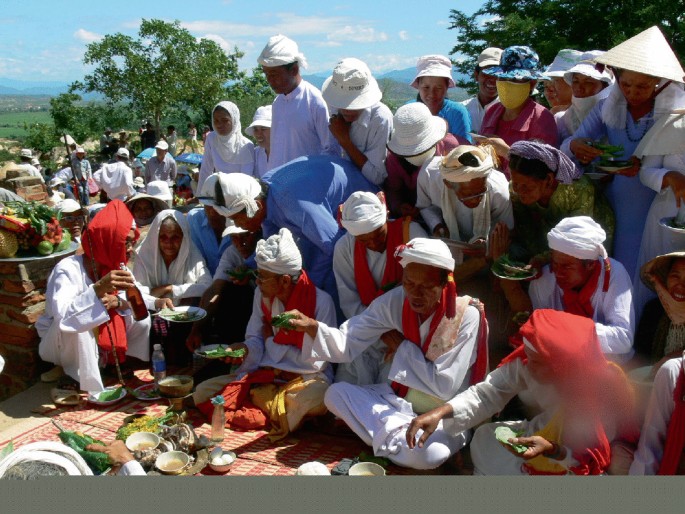
Elder priests performing rituals under the intense heat of the tropical sun
In this context, it is crucial for the local government to consider the well-being of the priests and provide them with adequate support, including basic health care and insurance, to help them carry out their duties and preserve the cultural heritage of the Cham people. The priests have dedicated their lives to the community, and it is only fair for the government to recognize their contributions and provide them with the support they deserve. Failure to do so could result in a loss of Cham cultural heritage, as younger generations may not be willing or able to continue the work of their elders.
During my fieldwork, I interviewed several individuals who expressed their views on the relationship between the local government and the Cham community in regard to tourism revenue. Many of these respondents believed that, as the authorities benefit from tourism at Cham temples, the government has a responsibility to provide support to the priests. One interviewee, Orang018, suggested that priests should receive a monthly salary so they could concentrate on their religious duties, or be hired as official tour guides at the temples. They explained that this would allow them to earn money to support their families while also introducing Cham culture in an accurate and honest way.
Orang005, who worked in the Balamon Dignitaries Council, shared their understanding of the economic difficulties faced by the Cham community, including the loss of fields for their livelihoods. They argued that the government should provide financial support to the priests to allow them to maintain the temples and share their knowledge with visitors.
Other interviewees, such as Orang17 and Orang024, emphasized the importance of using tourism revenue to improve the education and knowledge of young Cham priests. They believed that this would help them better contribute to the conservation and promotion of Cham culture. Orang024 explained that without the preservation of Cham heritage, there would be no tourism development and profit.
In short, many of the interviewees believed that the local government should use tourism revenue to support the Cham community, including providing financial support for priests, creating job opportunities for them as tour guides, and improving the education of young priests for better preservation of Cham culture. Some respondents argued that priests should receive a monthly salary, so they can focus on their duties and others felt that tourism revenue should be used to provide financial support for their daily lives and re-train them in heritage conservation. The overall sentiment was that tourism revenue is crucial for the Cham community, and should be used to promote and maintain their culture.
Achieving Fair Distribution of Tourism Revenues for Heritage Stewards
This chapter explores the difficulties faced by traditional Cham custodians in their efforts to conserve their cultural heritage and their views on the distribution of tourism benefits at their living heritage sites in Vietnam. The study reveals that the benefits of tourism are not fairly distributed among the Cham community, with most of the revenue going to the state and government staff. The economic hardships faced by the Cham priests, including limited educational opportunities and lack of financial support, put pressure on them to seek alternative sources of income, thus compromising their cultural and religious obligations. The unequal distribution of tourism revenues is a major barrier to successful and sustainable heritage conservation in the Cham community.
The role of Ahier priests in preserving Cham cultural heritage cannot be overstated, particularly in regard to the Cham living temples in Ninh Thuận Province. As the overseers of religious activities and teachers of Cham culture, these priests have maintained the manuscripts and passed on the knowledge of the Cham community’s history, astronomy, law, customs, literature, and the legacies of its kings (Abdul, 2013 ). However, previous studies (Mbaiwa & Stronza, 2010 ; Xu et al., 2009 ) on the economic benefits of tourism development for local communities have failed to consider the specific needs and challenges faced by those who play a crucial role in preserving Indigenous culture. This study confirms the significance of maintaining cultural heritage and highlights how the everyday concerns of the Ahier priests need to be taken into account in the management of heritage sites.
Given the crucial role that Ahier priests play in leading spiritual practices and cultural events at the temples, I argue that the management of living heritage sites should not only consider the values held by the living community, but also the social concerns of these priests. Jigyasu ( 2015 ) also argues that the management of living heritage sites must take into account the contemporary context and the immediate socio-economic challenges faced by local communities in light of damages to the heritage (Kong, 2008 ). The findings of this study are consistent with Ahebwa’s ( 2012 ) findings that such challenges must be recognized and managed when implementing TBS as a policy for sustainable tourism.
The findings of my research highlight the increasing recognition of Ahier priests by government authorities in the conservation and development activities at the Po Klaong Girai temple. This shift towards collaboration with Cham communities in co-managing their living heritage sites is commendable, but the socio-economic conditions of the Cham Ahier priests still require attention. Despite the priests being instrumental in preserving their cultural heritage, they do not receive any economic benefits from the heritage sites, which hinders their ability to preserve the resources and work effectively with the local government. This lack of recognition and financial support for the priests is not unique to Cham people. Many studies have shown that tourism can exacerbate inequality and inhibit the participation of local communities in the distribution of benefits (Archabald & Naughton-Treves, 2001 ; Heslinga et al., 2019 ; Spenceley et al., 2017 ; Tumusiime & Sjaastad, 2014 ). This can lead to conflict between the financial beneficiaries of tourism and the cultural owners of the heritage, as seen with the Cham Ahier priests. The failure to address this conflict can have negative impacts on the economic, cultural, social, and political lives of stakeholders (Jamal & Stronza, 2009 ).
This study adds to the body of literature (Queiros & Mearns, 2019 ; Tumusiime & Sjaastad, 2014 ; Walpole & Goodwin, 2001 ) that demonstrates the importance of sharing tourism benefits fairly and recognizing the importance of local communities in the conservation of heritage sites. The Ahier priests, who play a central role in maintaining the spiritual activities and cultural events at the temple, require financial support for their livelihoods, education, and health care. Providing this support through TBS is necessary to foster their participation in the conservation of Cham living heritage sites and overcome their economic and educational challenges. The findings from this research align with studies that highlight the unequal distribution of benefits from tourism (Huong, 2015 ; Miura, 2005 ). In the case of the Po Klaong Girai temple, it is clear that the local Cham community is not receiving the same economic benefits from the temple that other communities, such as those near Angkor Wat and Hoi An, are receiving from their respective heritage sites. Unlike these communities, the livelihoods of the Cham people are not tied to the landscape around the temple, but rather to the resources they need to maintain their cultural traditions. This unequal distribution of benefits can lead to conflicts between the financial beneficiaries of tourism and the cultural owners of heritage sites, as has been demonstrated in several studies (Jamal & Stronza, 2009 ; Queiros & Mearns, 2019 ; Tumusiime & Sjaastad, 2014 ; Walpole & Goodwin, 2001 ). In the case of the Cham people, this conflict is exacerbated by the lack of recognition of the socio-economic conditions of the Ahier priests, who face significant economic and educational difficulties that pose a threat to the sustainability of their living heritage sites.
To mitigate these challenges and ensure the preservation of the Cham living heritage, it is necessary for the local government to provide the necessary support to the Ahier priests, including financial support for their livelihoods, education, and health care. This support is critical to overcome the economic and educational difficulties facing the Ahier priests, and to foster and encourage their participation in the conservation of the Cham living heritage sites (Kong, 2008 ). Failure to provide this support could result in the loss of vitality and outstanding universal values associated with these sacred temples, highlighting the need for prompt action.
My research reveals a distinct case of benefit-sharing ambiguity in the laws, policies, and mechanisms of the Vietnamese government, particularly with regard to the Heritage Legislation of Vietnam. Despite the law stipulating the sharing of economic benefits to the local community (as noted in studies by Heslinga et al. in 2019 and Scheyvens in 2002 ), the Heritage Legislation of Vietnam fails to consider the rights, justice, and economic benefits for those who are responsible for maintaining the cultural heritage. Although the Hoi An Protocols mention the importance of cultural resources for “sustained and equitable social and economic development” (Engelhardt & Rogers, 2009 , p. 2), there is a need for clearer language to define what is meant by “sustained” and “equitable,” especially in the context of rapid socio-economic transformation affecting Indigenous communities. This lack of consideration for the social aspects of local communities, as highlighted by Kong ( 2008 , p. 14), contributes to ineffective management of living heritage sites, as noted by Weise ( 2013 ).
Weise ( 2013 ) highlights the importance of considering the needs of local communities in the relationship between heritage sites and their surrounding communities. The living heritage of these communities, including their traditional practices, must be valued and protected. The cultural richness of heritage sites, such as the Po Klaong Girai temple, is derived not only from its architectural design, but also from the spiritual and ritual practices that give the site its “life force.” This is why it is crucial to ensure that the local communities who maintain and practice their living heritage at these sites also benefit from their preservation and conservation. As Miura ( 2008 ) points out, conserving heritage without considering the daily needs of the living population can result in a “frozen past.” Given the significance of Cham heritage in Ninh Thuận Province, it is imperative that the benefits of its conservation are shared by all stakeholders, including the local community. The need for community participation in heritage conservation is emphasized by Kong ( 2008 ), who argues that effective management of living heritage sites must consider the social considerations of local communities. This can be achieved through providing institutional and financial support that is equitable and respectful of local traditions. Only by taking these steps can we ensure sustainable development and effective conservation of the living heritage of the Cham community.
My research findings highlight the ongoing struggles of the Cham community in terms of their involvement and benefit-sharing in the Tourism Based Services (TBS) at their living heritage site. Despite their crucial role in preserving the heritage, the Cham dignitaries have expressed their disappointment and frustration over the lack of recognition and profit-sharing from the tourism industry. My study sheds light on the perspectives and experiences of the core communities who are directly involved in preserving the living heritage site. Previous studies have emphasized the importance of community participation and benefit-sharing in TBS (Makame & Boon, 2017 ; Munanura et al., 2016 ; Snyman & Bricker, 2019 ). However, this research highlights the need for further examination on TBS and its impact on the social and economic well-being of local communities. It is crucial to ensure that the distribution of tourism benefits is equitable and that the local communities are not detached from their living heritage sites. This study therefore calls for further research to address these pressing concerns and ensure the sustainability of both the heritage sites and the communities that hold them dear.
This study sheds light on the pressing issue of benefit-sharing for the Cham community in the context of TBS at their living heritage site. It highlights the importance of involving the community, particularly the cultural carriers, in the preservation and promotion of their living heritage. As pointed out by Jamal and Stronza ( 2009 ) and Lindberg ( 1991 ), the community’s participation and contribution are crucial for successful heritage conservation and sustainable development. The findings of this study are consistent with those of previous studies on TBS, such as those by Makame and Boon ( 2017 ), Munanura et al. ( 2016 ), and Snyman and Bricker ( 2019 ). These studies emphasize the negative impact of unfair TBS on tourism development and heritage conservation. Snyman and Bricker ( 2019 ) also underscore the importance of community attitudes and willingness to contribute to conservation efforts. However, the current heritage and tourism laws in Vietnam overlook the rights, justice, and economic benefits of the community, who are the creators and bearers of cultural heritage. This study aligns with the findings of Lapeyre ( 2011 ) and Tumusiime and Vedeld ( 2012 ), who argue that tourism development must critically consider the real benefits for the environment and the host community. It calls for a reexamination of these laws and policies to ensure that the benefits of tourism development at cultural heritage sites are shared fairly and equitably with the local communities.
This research sheds light on the challenges faced by the Cham community in preserving and promoting their cultural heritage through TBS at their living sacred sites in Ninh Thuận Province, Vietnam. The study highlights that the Cham people face significant economic and educational barriers that hinder the preservation and development of their cultural heritage. Moreover, the community has expressed their dissatisfaction with the unequal distribution of tourism benefits, which raises questions about the fairness towards the owners and bearers of cultural heritage.
While previous research has focused on TBS in protected areas in Africa, this study emphasizes the importance of considering the perspectives of Indigenous and ethnic communities in living heritage sites. The participation of the host community is critical in preserving cultural heritage and promoting sustainable tourism development. Listening to the voices of Indigenous and ethnic people who play a crucial role in preserving cultural heritage is crucial to address the challenges faced in preserving and promoting heritage values.
This research offers evidence for improving heritage management practices by proposing tourism development policies that promote equality and justice among stakeholders, especially minority and disadvantaged groups. It serves as a valuable lesson for sustainable heritage management in living heritage sites in other ethnic minority areas in Vietnam and around the world.
Abdul, M. E. (2013). Nager Cam and the priests of prowess: A history of resilience . University of Hawaii at Manoa.
Google Scholar
Abungu, G. O. (2015). UNESCO, the World Heritage convention, and Africa: The practice and the practitioners. In W. Logan, M. N. Craith, & U. Kockel (Eds.), A companion to heritage studies (pp. 373–391). Wiley-Blackwell.
Chapter Google Scholar
Abungu, G. O., & Githitho, A. (2012). Homelands of the Mijikenda people: Sacred Mijikenda Kaya Forests, Kenya. In A. Galla (Ed.), World Heritage benefits beyond borders (pp. 147–157). Cambridge University Press. https://doi.org/10.1017/CBO9781139567657
Adams, W. M., Aveling, R., Brockington, D., Dickson, B., Elliott, J., Hutton, J., Roe, D., Vira, B., & Wolmer, W. (2004). Biodiversity conservation and the eradication of poverty. Science, 306 (5699), 1146–1149. https://doi.org/10.1126/science.1097920
Ahebwa, W. M., van der Duim, R., & Sandbrook, C. (2012). Tourism revenue sharing policy at Bwindi Impenetrable National Park, Uganda: A policy arrangements approach. Journal of Sustainable Tourism, 20 (3), 377–394. https://doi.org/10.1080/09669582.2011.622768
Akbar, I., & Yang, Z. (2021). The influence of tourism revenue sharing constraints on sustainable tourism development: A study of Aksu-Jabagly nature reserve, Kazakhstan. Asian Geographer, 39 (2), 133–153. https://doi.org/10.1080/10225706.2021.1894462
Archabald, K., & Naughton-Treves, L. (2001). Tourism revenue-sharing around national parks in Western Uganda: Early efforts to identify and reward local communities. Environmental Conservation . https://doi.org/10.1017/S0376892901000145
Article Google Scholar
Baghai, M., Miller, J. R. B., Blanken, L. J., Dublin, H. T., Fitzgerald, K. H., Gandiwa, P., Laurenson, K., Milanzi, J., Nelson, A., & Lindsey, P. (2018). Models for the collaborative management of Africa’s protected areas. Biological Conservation, 218 , 73–82. https://doi.org/10.1016/j.biocon.2017.11.025
Balmford, A., Beresford, J., Green, J., Naidoo, R., Walpole, M., & Manica, A. (2009). A global perspective on trends in nature-based tourism. PLoS Biology, 7 (6). https://doi.org/10.1371/journal.pbio.1000144
Bebbington, A. (1999). Capitals and capabilities: A framework for analyzing peasant viability, rural livelihoods and poverty. World Development . https://doi.org/10.1016/S0305-750X(99)00104-7
Benjaminsen, T. A., & Svarstad, H. (2010). The death of an elephant: Conservation discourses versus practices in Africa. Forum for Development Studies, 37 (3), 385–408. https://doi.org/10.1080/08039410.2010.516406
Biên, P. X., An, P., & Van Dop, P. (1989). The Cham people in Thuan Hai Province [Người Chăm ở Thuận Hải]. Văn hoá Thông tin Thuận Hải.
Biên, P. X., An, P., & Van Dop, P. (1991). The Cham culture [Văn hoá Chăm]. KHXH.
Bruyere, B. L., Beh, A. W., & Lelengula, G. (2009). Differences in perceptions of communication, tourism benefits, and management issues in a protected area of rural Kenya. Environmental Management, 43 (1), 49–59. https://doi.org/10.1007/s00267-008-9190-7
Bwasiri, E. (2011). The implications of the management of Indigenous living heritage: The case study of the Mongomi Wa Kolo rock paintings World Heritage Site, Central Tanzania. The South African Archaeological Bulletin, 66 (193), 60–66.
Byrne, D. (2012). Buddhist stupas and Thai Social Practice. In S. Sullivan & R. Mackay (Eds.), Archaeological sites: Conservation and management (pp. 572–587). Getty Conservation Institute.
Carius, F., & Job, H. (2019). Community involvement and tourism revenue sharing as contributing factors to the UN Sustainable Development Goals in Jozani–Chwaka Bay National Park and Biosphere Reserve, Zanzibar. Journal of Sustainable Tourism, 27 (6), 826–846. https://doi.org/10.1080/09669582.2018.1560457
Chirikure, S., Manyanga, M., Ndoro, W., & Pwiti, G. (2010). Unfulfilled promises? Heritage management and community participation at some of Africa’s cultural heritage sites. International Journal of Heritage Studies, 16 (1–2), 30–44. https://doi.org/10.1080/13527250903441739
Engelhardt, R. A., & Rogers, P. R. (2009). Hoi An protocols for best conservation practice in Asia: Professional guidelines for assuring and preserving the authenticity of heritage sites in the context of the cultures of Asia . UNESCO Bangkok.
Fletcher, R., Johnson, I., Bruce, E., & Khun-Neay, K. (2007). Living with heritage: Site monitoring and heritage values in Greater Angkor and the Angkor World Heritage Site. Cambodia. World Archaeology, 39 (3), 385–405. https://doi.org/10.1080/00438240701465001
Gautam, A. P. (2009). Equity and livelihoods in Nepal’s community forestry. International Journal of Social Forestry, 2 (2), 101–122.
Harris, R. B. (1991). Conservation prospects for musk deer and other wildlife in southern Qinghai, China. Mountain Research and Development, 11 (4), 353–358. https://doi.org/10.1016/0006-3207(93)90773-T
Heslinga, J., Groote, P., & Vanclay, F. (2019). Strengthening governance processes to improve benefit-sharing from tourism in protected areas by using stakeholder analysis. Journal of Sustainable Tourism, 27 (6), 773–787. https://doi.org/10.1080/09669582.2017.1408635
Huong, P. T. T. (2015). Living heritage, community participation and sustainability: Redefining development strategies in Hoi An Ancient Town World Heritage property, Viet Nam. In W. L. Sophia Labadi (Ed.), Urban heritage, development and sustainability international frameworks, national and local governance (pp. 274–290). Routledge.
Imanishimwe, A., Niyonzima, T., & Nsabimana, D. (2018). Contribution of community conservation and ecotourism projects on improving livelihoods and sustainable biodiversity conservation in and around Nyungwe National Park (NNP). Journal of Tourism & Hospitality, 7 (4). https://doi.org/10.4172/2167-0269.1000363
Jamal, T., & Stronza, A. (2009). Collaboration theory and tourism practice in protected areas: Stakeholders, structuring and sustainability. Journal of Sustainable Tourism . https://doi.org/10.1080/09669580802495741
Jigyasu, R. (2015). The intangible dimension of urban heritage. In F. Bandarin & R. van Oers (Eds.), Reconnecting the city (pp. 130–159). Wiley. https://doi.org/10.1002/9781118383940
Jones, E. R. (2007). Three management challenges for protection of aboriginal cultural heritage in a Tasmanian multiple-use conservation area. Australian Geographer, 38 (1), 93–112.
Kiss, A. (2004). Is community-based ecotourism a good use of biodiversity conservation funds? Trends in Ecology and Evolution . https://doi.org/10.1016/j.tree.2004.03.010
Kong, P. (2008). Social quality in the conservation process of living heritage sites . International Forum on Urbanism (IFoU).
Lapeyre, R. (2011). The Grootberg lodge partnership in Namibia: Towards poverty alleviation and empowerment for long-term sustainability? Current Issues in Tourism, 14 (3), 221–234. https://doi.org/10.1080/13683500.2011.555521
Lask, T., & Herold, S. (2004). An observation station for culture and tourism in Vietnam: A forum for World Heritage and public participation. Current Issues in Tourism, 7 (4–5), 399–411.
Li, W. (2006). Community decisionmaking participation in development. Annals of Tourism Research, 33 (1), 132–143. https://doi.org/10.1016/j.annals.2005.07.003
Lindberg, K. (1991). Policies for maximizing nature tourism’s ecological and economic benefits. In International conservation financing project working paper (p. 37). World Resources Institute (WRI).
MacKenzie, C. A. (2012). Trenches like fences make good neighbours: Revenue sharing around Kibale National Park, Uganda. Journal for Nature Conservation, 20 (2), 92–100. https://doi.org/10.1016/j.jnc.2011.08.006
Makame, M. K., & Boon, E. K. (2017). Sustainable tourism and benefit-sharing in Zanzibar: The case of Kiwengwa-Pongwe forest reserve. Journal of Human Ecology, 24 (2), 93–109. https://doi.org/10.1080/09709274.2008.11906105
Mbaiwa, J. E., & Stronza, A. L. (2010). The effects of tourism development on rural livelihoods in the Okavango Delta, Botswana. Journal of Sustainable Tourism, 18 (5), 635–656. https://doi.org/10.1080/09669581003653500
Melita, A. W., & Mendlinger, S. (2013). The impact of tourism revenue on the local communities’ livelihood: A case study of Ngorongoro conservation area, Tanzania. Journal of Service Science and Management, 6 (1), 117–126. https://doi.org/10.4236/jssm.2013.61012
Miura, K. (2005). Conservation of a ‘living heritage site’: A contradiction in terms? A case study of Angkor World Heritage Site. Conservation and Management of Archaeological Sites, 7 (1), 3–18. https://doi.org/10.1179/135050305793137602
Miura, K. (2008). The need for anthropological approaches to conservation and management of living heritage sites: A case study of Angkor, Cambodia. In I. C. Glover, P. D. Sharrock, & A. B. Elisabeth (Eds.), Interpreting Southeast Asia’s past: Monument, image and text (pp. 377–390). NUS Press Pte Ltd. https://muse.jhu.edu/chapter/883481
Mukanjari, S., Bednar-Friedl, B., Muchapondwa, E., & Zikhali, P. (2013). Evaluating the prospects of benefit sharing schemes in protecting mountain gorillas in Central Africa. Natural Resource Modeling, 26 (4), 455–479. https://doi.org/10.1111/nrm.12010
Munanura, I. E., Backman, K. F., Hallo, J. C., & Powell, R. B. (2016). Perceptions of tourism revenue sharing impacts on Volcanoes National Park, Rwanda: A sustainable livelihoods framework. Journal of Sustainable Tourism . https://doi.org/10.1080/09669582.2016.1145228
Ndoro, W. (2004). Traditional and customary heritage systems: Nostalgia or reality? The implications of managing heritage sites in Africa. In R. Smeets, C. Westrick, & E. de Merode (Eds.), Linking universal and local values: Managing a sustainable future for World Heritage (pp. 81–84). UNESCO World Heritage Centre.
Ndoro, W., & Wijesuriya, G. (2015). Heritage management and conservation: From Colonisation to Globalisation. In L. Meskell (Ed.), Global heritage: A reader (pp. 131–149). Wiley-Blackwell.
Norton, A., & Foster, M. (2001). The potential of using sustainable livelihoods approaches in poverty reduction strategy papers (No. 148). ISBN: 85003 528 7.
Noseworthy, W. (2017). Khik Agama Cam: Caring for Cham religions in Mainland Southeast Asia, 1651–1969. University of Wiscosin-Madison.
Queiros, D., & Mearns, K. (2019). Khanyayo village and Mkhambathi Nature Reserve, South Africa: A pragmatic qualitative investigation into attitudes towards a protected area. Journal of Sustainable Tourism, 27 (6), 750–772. https://doi.org/10.1080/09669582.2018.1436177
Sakaya. (2003). The festivals of the Cham people [Lễ hội của người Chăm]. NXB Van Hoa Dan Toc.
Salemink, O. (2013). Appropriating culture: The politics of intangible cultural heritage in Vietnam. In H.-T. Ho Tai. & M. Sidel (Eds.), State, society and the market in contemporary Vietnam: Property, power and values (pp. 158–180). Routledge. https://doi.org/10.4324/9780203098318
Saltiel, L. (2014). Cultural governance and development in Vietnam. University of Pennsylvania Journal of International Law, 35 (3), 893–915. https://scholarship.law.upenn.edu/jil/vol35/iss3/6
Sandbrook, C. G. (2010). Putting leakage in its place: The significance of retained tourism revenue in the local context in rural Uganda. Journal of International Development, 22 (1), 124–136. https://doi.org/10.1002/jid.1507
Scheyvens, R. (2002). Tourism for development: Empowering communities . Themes in Tourism Series (Vol. 27). https://doi.org/10.1016/j.tourman.2005.07.013
Schnegg, M., & Kiaka, R. D. (2018). Subsidized elephants: Community-based resource governance and environmental (in)justice in Namibia. Geoforum, 93 , 105–115. https://doi.org/10.1016/j.geoforum.2018.05.010
Sharma, T. (2013). A community-based approach to heritage management from Ladakh, India. In K. D. Silva & N. K. Chapagain (Eds.), Asian heritage management: Contexts, concerns, and prospects (pp. 271–284). Routledge.
Shen, X., Lu, Z., Li, S., & Chen, N. (2012). Tibetan sacred sites: Understanding the traditional management system and its role in modern conservation. Ecology and Society, 17 (2). https://doi.org/10.5751/ES-04785-170213
Smith, A., & Turk, C. (2013). Customary systems of management and World Heritage in the Pacific Islands. In S. Brockwell, S. O’Connor, & D. Byrne (Eds.), Transcending the culture–nature divide in cultural heritage: Views from the Asia-Pacific Region (pp. 23–34). ANU E Press.
Smith, L., & Waterton, E. (2009). Heritage, communities and archaeology. Duckworth Debates in Archaeology . Bloomsbury Academic.
Snyman, S., & Bricker, K. S. (2019). Living on the edge: Benefit-sharing from protected area tourism. Journal of Sustainable Tourism, 27 (6), 705–719. https://doi.org/10.1080/09669582.2019.1615496
Sở VH-TT-DL. (2020). Ninh Thuan tourism activity in 2019 [Hoạt động du lịch năm 2019].
Spenceley, A., Snyman, S., & Rylance, A. (2017). Revenue sharing from tourism in terrestrial African protected areas. Journal of Sustainable Tourism . https://doi.org/10.1080/09669582.2017.1401632
Strickland-Munro, J., & Moore, S. (2013). Indigenous involvement and benefits from tourism in protected areas: A study of Purnululu National Park and Warmun Community, Australia. Journal of Sustainable Tourism, 21 (1), 26–41. https://doi.org/10.1080/09669582.2012.680466
Truong, V. D. (2013). Tourism policy development in Vietnam: A pro-poor perspective. Journal of Policy Research in Tourism, Leisure and Events, 5 (1), 28–45. https://doi.org/10.1080/19407963.2012.760224
Tumusiime, D. M., & Sjaastad, E. (2014). Conservation and development: Justice, inequality, and attitudes around Bwindi Impenetrable National Park. Journal of Development Studies, 50 (2), 204–225. https://doi.org/10.1080/00220388.2013.841886
Tumusiime, D. M., & Vedeld, P. (2012). False promise or false premise? Using tourism revenue sharing to promote conservation and poverty reduction in Uganda. Conservation and Society, 10 (1), 15–28. https://doi.org/10.4103/0972-4923.92189
UNESCO. (2013). Operational guidelines for the implementation of the World Heritage Convention . Operational Guidelines for the Implementation of the World Heritage Convention.
Walpole, M. J., & Goodwin, H. J. (2001). Local attitudes towards conservation and tourism around Komodo National Park, Indonesia. Environmental Conservation, 28 (2), 160–166. https://doi.org/10.1017/S0376892901000169
Waterton, E. (2010). Politics, policy and the discourses of heritage in Britain . Palgrave Macmillan.
Waterton, E. (2015). Heritage and community engagement. In The ethics of cultural heritage (pp. 53–67). Palgrave Macmillan. https://doi.org/10.1007/978-1-4939-1649-8_4
Weise, K. (2013). Discourse. In K. Weise (Ed.), Revisiting Kathmandu safeguarding living urban heritage (pp. 1–52). UNESCO. Kathmandu Office. https://publik.tuwien.ac.at/files/publik_229747.pdf
Weisse, A., & Ross, A. (2017). Managing a contested cultural heritage place on K’gari (Fraser Island), Queensland, Australia. Archaeology in Oceania, 52 (3), 149–160. https://doi.org/10.1002/arco.5130
Wunder, S. (2000). Ecotourism and economic incentives—An empirical approach. Ecological Economics . https://doi.org/10.1016/S0921-8009(99)00119-6
Xu, J., Lü, Y., Chen, L., & Liu, Y. (2009). Contribution of tourism development to protected area management: Local stakeholder perspectives. International Journal of Sustainable Development and World Ecology, 16 (1), 30–36. https://doi.org/10.1080/13504500902757189
Download references
Author information
Authors and affiliations.
Faculty of Tourism, Nguyen Tat Thanh University, Ho Chi Minh City, Vietnam
Quang Dai Tuyen
You can also search for this author in PubMed Google Scholar
Corresponding author
Correspondence to Quang Dai Tuyen .
Rights and permissions
Open Access This chapter is licensed under the terms of the Creative Commons Attribution 4.0 International License ( http://creativecommons.org/licenses/by/4.0/ ), which permits use, sharing, adaptation, distribution and reproduction in any medium or format, as long as you give appropriate credit to the original author(s) and the source, provide a link to the Creative Commons license and indicate if changes were made.
The images or other third party material in this chapter are included in the chapter's Creative Commons license, unless indicated otherwise in a credit line to the material. If material is not included in the chapter's Creative Commons license and your intended use is not permitted by statutory regulation or exceeds the permitted use, you will need to obtain permission directly from the copyright holder.
Reprints and permissions
Copyright information
© 2023 The Author(s)
About this chapter
Tuyen, Q.D. (2023). Navigating the Balance Between Revenue Generation and Conservation at a Cham Living Sacred Heritage Site: Priestly Views and Challenges. In: Heritage Conservation and Tourism Development at Cham Sacred Sites in Vietnam. Global Vietnam: Across Time, Space and Community. Springer, Singapore. https://doi.org/10.1007/978-981-99-3350-1_9

Download citation
DOI : https://doi.org/10.1007/978-981-99-3350-1_9
Published : 13 October 2023
Publisher Name : Springer, Singapore
Print ISBN : 978-981-99-3349-5
Online ISBN : 978-981-99-3350-1
eBook Packages : Literature, Cultural and Media Studies Literature, Cultural and Media Studies (R0)
Share this chapter
Anyone you share the following link with will be able to read this content:
Sorry, a shareable link is not currently available for this article.
Provided by the Springer Nature SharedIt content-sharing initiative
- Publish with us
Policies and ethics
- Find a journal
- Track your research
- International edition
- Australia edition
- Europe edition

How Rwanda's gorillas are helping to sustain entire communities
C onsole Nyirabatangana sits on a stool outside her three-bedroom house preparing the evening meal and, as the sun sets over Volcanoes national park in north-west Rwanda , she reflects on another day of being thankful.
Facing the towering peaks that have in many ways contributed to her wellbeing, Nyirabatangana is in a hurry to have dinner ready in time for her family. She cuts tomatoes and onions, and peels Irish potatoes, all from her garden. With a smile, she sings along to a song on the radio.
If it were not for an innovative approach to tourism, however, life would have been very different for the 55-year-old. A decade ago, Nyirabatangana was living below the poverty line of $2 a day . She could barely afford one meal a day for her family. "We went hungry for days and woke up every morning wishing we could get just a meal a day," she says. "It was a difficult time for us."

The mother of five, whose husband died in 1995, has been able to feed and educate her children using the money extended to members of her community through one of the projects funded by gorilla tourism in Rwanda. Her eldest child, Christine Ndacyayisaba, 22, completed school and a diploma in education, and is a teacher in Gasizi, a village in Musanze, near the national park.
Rwanda is well known for mountain gorillas – an endangered species found only in the border areas between Rwanda, Uganda and the Democratic Republic of the Congo – and hosted more than a million visitors between 2006-13, generating from the national parks alone $75m (£44m) in tourism revenue in that time; 85% of this is from trekkers who come to see some of the country's 500 gorillas.
In 2005, the Rwandan government initiated a tourism revenue-sharing scheme, whereby 5% of annual income from national parks is disbursed to communities. As a result, $1.83m has been distributed over the past nine years to fund 360 community projects across the country , ranging from roads, bridges, bee-keeping, water and sanitation, small and medium enterprises, and handicrafts. The Rwanda Development Board (RDB) estimates that 39,000 people have benefitted from this tourism.
The home of the Rwandan gorillas is the Volcanoes national park in Kinigi, close to the border with DRC, where communities are allocated 40% of the scheme; communities around Nyungwe forest in the south-west and Akagera national park in the east each receive 30%.

NGOs are involved in the implementation of community initiatives, but the government works hard to ensure that decisions on which projects get funded are made locally. "We sit down with community leaders and decide how to distribute the money according to the priorities in the area, to address the issues that prevail in the area," says the RDB's conservation division manager, Telesphore Ngoga.
Transparency is ensured by regular follow-ups and by the presentation of financial reports at monthly and annual meetings of the RDB, community leaders and the boards that run the various cooperatives.
Many of the projects incorporate a strong theme of sustainability. In the past, for example, villagers would go into the forests of the Volcanoes park to collect wild honey, interrupting the delicate ecosystem that sustains the gorilla populations. However, thanks to the tourism revenue, communities formed cooperative societies, and some have become bee-keepers and farmers.
In addition to community projects, the tourism revenue has been used for public works – the government has built 57 primary schools in 13 districts, serving approximately 13,700 students over the past decade, 12 health centres have been built, along with roads and bridges.
However, the scheme has not had universal approval. Jean de Muru Habyarabatuma, who has been a guide at Volcanoes for five years, says he does not profit from the tourism sector. He is neither paid for his services nor does he receive any of the money given to other members of the community. "I have been working in this park since 2009 and I have never received any money like the other people," the 35-year-old father of three said.
Habyarabatuma survives on the little money he gets from odd jobs such as clearing people's compounds. He says he has complained many times to the park officials, but because he loves the work and has always dreamed of being part of conservation efforts in his community, he continues to work as a guide, albeit an unpaid one.
For Nyirabatangana, though, the scheme has transformed her and her children's lives. She was able to buy a hectare of land to grow potatoes, and says: "As a widow, this project has helped me to run my family including paying school fees, buying food and facilitating my farming.
"I really don't know what would have happened to us if we weren't part of this scheme. Our lives have completely turned around and now we can afford to have a nice meal three times a day and buy clothes."
- Natural resources and development

Talk point: Tourism and development
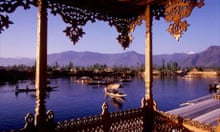
Kashmir desperate for the return of tourists after two decades of violence

Charity condemns tourists' use of fresh water in developing countries
Comments (…), most viewed.
Rwanda Tourism Revenue Sharing
- Goals, objectives and guiding principles for revenue sharing
- Specific Revenue Sharing policies
- Guidelines for implementation
- Management structure and the project cycle
- Roles and responsibilities of the key players
- Harmonised procedures for selecting projects
- Mode and procedures for allocating and disbursing funds
- Evaluation of impacts and strategy review
Tourism Revenue Sharing in Rwanda
- Conservation impact objectives: to reduce illegal activities; to ensure sustainable conservation; and to increase community responsibility for conservation
- Livelihoods impact objectives: to improve livelihoods by contributing to poverty reduction; to compensate for loss of access and/or crop damage; to provide alternatives to park resources; and to encourage community based tourism
- Relationship impact objectives (between park and population): to build trust; to increase ownership; to reduce conflicts; to increase participation in conservation; and to empower communities
- National Stakeholder’s Workshop Presentation
- Presentation of Draft Report to RDB
- Policy Briefs / Summary Documents
- Draft Report
- Final Report
- Peer Review Publication (optional)
- Inception Report / Questionnaires for the stakeholder interview

The ALU School of Wildlife Conservation is the first of its kind on the continent, dedicated to growing the next generation of world class conservation leaders in Africa.
The continent needs home grown African leaders to spearhead new and innovative approaches in the business of conservation.
- Our Advisors
- Our Programmes
- Circular Economy
- Get Involved
Stay in the Know
- Donate to SOWC
Sign up to our newsletter
Alu school of wildlife conservation.
Bumbogo, Kigali Innovation City, Next to Azam, Kigali, Rwanda Phone: +250 784 650 219

Special report: The power of the GCC as a source market for global tourism
The size and monetary value of the outbound GCC tourism market were never in question – but what are its challenges, opportunities and key growth drivers in the foreseeable future?
That the GCC market comprising Saudi Arabia, the UAE, Bahrain, Qatar, Kuwait and Oman, can prove to be an incredibly lucrative source market for global tourism is beyond doubt.
According to figures shared by the United Nations World Travel Organisation (UNWTO), international tourism expenditure from the GCC climbed from $40bn in 2010 to $60bn in 2017, with per capita expenditure of individuals from the GCC 6.5 times higher than other regions worldwide. Tourism boards across the world are only too aware of the fact.
“All over the world, [visitors from the GCC] are known as travellers with high solvency: their average spending on foreign trips is $1,700-$3,000,” says Anastasia Popova, head of International Division, Moscow City Tourism Committee.
While outbound tourism from the GCC means tens of billions spent in the destination countries, it also presents an opportunity for entities within the originating country. These could imply revenue streams for tour operators, airlines and travel insurance providers, among others, which stand to gain when the country’s residents book their foreign trip. According to data shared by Research and Markets, the Saudi revenue from its outbound travel and tourism market is projected to grow at a CAGR of 18.21 per cent from 2021-2028, reaching $27bn by 2028.
There are positive figures for almost all the other GCC markets. The UAE, which has the Arab world’s second-largest economy – and which has an approximately 90 per cent expat population – is expected to gather a revenue of $30.5bn by 2028 by way of outbound travel, Qatar will raise $13bn by then, and Kuwait will notch up $17bn in revenue from this avenue by 2028 (up from approximately $12bn in 2019.)
A pandemic-proof region The pandemic has undoubtedly pushed global tourism off a cliff. The UNWTO said that in 2020 international arrivals plummeted by more than 70 per cent, to levels not seen in over three decades. It estimated that the decline resulted in a loss of about 1 billion arrivals and $1.1 trillion by way of international tourism receipts.

At the time, UNWTO projected a rebound in international tourism over the second half of 2021, though cautioned that a return to 2019 levels in terms of international arrivals could take between 2½-4 years. However, preliminary data released earlier this year by UNWTO showed that while there was a 4 per cent year-on-year increase in international tourists’ arrivals in 2021, overall, these figures were still 72 per cent below pre-pandemic levels of 2019, highlighting the need for a more sustained and uniform recovery.
There are tourism destinations that bucked the trend last year – especially when it comes to attracting visitors from the GCC. Switzerland is a prime example. According to figures shared by Switzerland Tourism as well as from the Swiss Department of Statistics, from July-November 2021, there was a 2,107 per cent growth in the number of arrivals from the UAE compared to the same period in 2020 – it isn’t unusual for tourism boards to report such large differences over 2020 when most of the world was under lockdown for several months and stringent travel restrictions remained in place.
However, Switzerland Tourism’s highlight is that the July-November 2021 arrivals of 201,670 people from the UAE was 19.5 per cent higher than the 168,701 individuals that travelled from the UAE over the same period in 2019 – which means that as far as visits from the UAE are concerned. Switzerland is beating its pre-pandemic figures. From the GCC alone, Swiss Tourism received 352,956 visitors, who in turn generated 15.7 million overnights in the Alpine country from July-November last year. Pre-pandemic figures shared by Switzerland suggested that Saudi and the UAE account for around 35 per cent of its arrivals from the GCC, while Kuwait and Qatar recorded 13 per cent, and Bahrain and Oman followed at between 2-3 per cent.
Another region that is bucking the trend is the UK.
“Flight bookings data from ForwardKeys has shown signs of recovery from the Middle East when it comes to arrivals into the UK in recent months. The most favourable week so far for the Middle East was in late November, when arrivals reached 78 per cent of pre-Covid levels, outperforming all other global regions,” says Jennifer Huntley, head of partnerships, APMEA region for VisitBritain.
“In our most recent year of full data, 2019, 1.2 million visitors came to the UK from the GCC, and those visitors spent GBP2.6bn during their stays. GCC visitors stayed on average 12 nights, and spent GBP2,151 per visit. On average, from 2017-2019, 45 per cent of visits from the GCC originated from the UAE, 19 per cent from Saudi Arabia, 16 per cent from Kuwait, 13 per cent from Qatar, 4 per cent from Oman, and 3 per cent from Bahrain,” explains Huntley.
Huntley’s assessment of the lion’s share of visits from the region coming from the UAE, is supported by data released by the World Travel & Tourism Council in 2019 which found that while Saudi Arabia was the leading international market for outbound departures from the UAE with a share of 30 per cent, it was followed next by the UK at 17 per cent. The collective tourism potential of the GCC is further underscored by other destinations including Moscow. “The growing interest in Moscow is confirmed by statistics such as in the first nine months of 2021, there were 107,000 visitors from the Middle East, including almost 19,000 visitors from the UAE, 9,840 visitors from Qatar, and 3,815 visitors from Saudi Arabia,” observes Moscow tourism committee’s Popova.

A burgeoning GCC source market is true for the Far East as well, is also reflected in statistics by the Japan National Tourism Organization (JNTO). “In 2019, Japan saw a record high number of visitors from the GCC countries with 28,222 visitors making the journey, a 28.4 per cent increase on the previous year and the figure doubling in the past five years,” says Tomoko Kikuchi, executive director of JNTO’s Dubai office. Apart from the often-visited European, Asian and American haunts for GCC travellers, there are new markets that are only just opening to them – namely Israel.
“Following the signing of the Abraham Accords in 2020, the Israeli Ministry of Tourism held the first virtual joint tourism forum of the Emirates and Israel in December 2020. One of the main purposes of the forum was to create connections between Israel and UAE’s tourism industries and to initiate collaboration between the two markets in the tourism field,” says Ksenia Kobiakov, director of New Markets Development Department, at the Israel Ministry of Tourism.
“The UAE is a brand-new market for our ministry, specifically for our New Markets Development Department. We see great potential in incoming tourism from that destination. Therefore, we have put in action – and are already actively implementing – a detailed plan to promote tourism from UAE and Bahrain,” adds Kobiakov.
Local connections Realising the need to tailor their messaging for the region, global tourism boards are going the distance. JNTO, for example, opened its first Middle East office in Dubai last November.
By 2030, Japan intends to attract 60 million visitors with a projected annual consumption of JPY 15 trillion – and to get there, it’s going to need to make a big splash in the Middle East.
“According to a survey conducted by the JNTO in six GCC countries from May to June 2021, approximately 30 per cent of respondents answered that they would like to go to Japan in the future. Conversely, almost 40 per cent of the respondents answered: ‘I don’t know much about Japan’, presenting an opportunity for the JNTO Dubai office to broaden awareness and increase the number of visitors from the GCC,” says JNTO’s Dubai-based Kikuchi on the reason why it decided to open a representative office in Dubai in the midst of a pandemic.
Also last year, the UNWTO opened its first Middle East office in Riyadh in order to coordinate its initiatives and policies across 13 member states within the region.At times, attempts are being made at direct exchanges with local tourism boards from the region to learn best practices as well as to facilitate an exchange of knowledge.
“I am in touch with Dubai Tourism to develop collaborations,” says Fleur Hassan-Nahoum, deputy mayor of Jerusalem and co-founder of the UAE-Israel Business Council. “Our tourism ministries are in contact and working on [ways] to bring value to each other. We are getting requests about trips to Israel from a cross-section of the public in the Gulf.”
Expo 2020 Dubai particularly has been a focal point in the efforts of countries to drive tourism from the region to their destinations. As Kobiakov from Israel’s ministry of tourism points out, Israel had its pavilion at Expo Dubai 2020 opened by Israel Tourism Minister Yoel Razvozov.
VisitBritain, VisitScotland and Tourism Ireland meanwhile turned to the Expo to launch 10 new itineraries across the UK at the mega event. Some studies have also correlated a direct measurement of the impact that the Expo will have on driving out-bound tourism.
“Middle East tourism accounts for 1.3 per cent of the arrivals to Italy. It’s estimated that a 5 per cent increase of tourist flows to Italy following Expo Dubai would generate an economic value of EUR25.5m a year, accord-ing to the School of Management of Milan’s Politecnico,” says Paolo Glisenti, commissioner-general of Italy at Expo 2020 Dubai.The Expo has allowed international tourism boards operating in the UAE one more platform other than the traditional annual Arabian Travel Market held in Dubai every year.
“The Moscow City Tourism Committee will continue to forge links with travel influencers, major tour operators and MICE agencies in the region taking part in Arabian Travel Market and events dedicated to the business travel: Meetings Arabia and Luxury Travel Congress (MALT) and Qatar Business and Luxury Travel Congress (QBLT),” explains Popova.
Foreign tourism boards, as part of their local outreach initiatives, are also working closely with influencers from the region. Switzerland’s tourism board, for example, collaborated with Raha Moharrak, the youngest Arab and first Saudi woman to climb Mount Everest, as well as Sara Murad and Haya Yasmeen to participate in the Swiss “100% Women” initiative where 700 women from 20 countries scaled all of the 4,000-metre-plus peaks in Switzerland last year.
In another initiative, Swiss Tourism also partnered with the wildly popular Dubai-based Supercar Blondie who undertook a Grand Tour of Switzerland and produced content for her over seven million followers on YouTube and close to 10 million followers on Instagram.
Growth drivers There are going to be a handful of key drivers in growing the outbound GCC tourism market. These include intra-GCC travel whereby residents of countries are encouraged to visit other GCC markets, the role of airlines and finally, governmental policies that encourage travel.

According to data shared by the GCC Statistical Centre in Muscat, in 2019, the percentage of intra-tourism among GCC countries reached approximately 28.7 per cent of the total number of foreign tourists arriving within the GCC states. Reportedly, in Bahrain, 95.6 per cent of all the international tourists it received were from other GCC countries. The numbers varied for countries such as the UAE where 15.4 per cent of all its international tourists were from GCC countries, whereas in Saudi that figure stood at 26.5 per cent – indicating the potential of each GCC country to either further encourage travel from within the GCC, or as in the case of Bahrain, encourage it to open up further to tourists from beyond the GCC.
Playing a crucial role in stimulating an appetite to travel beyond national borders are airlines. Within months of the signing of the Abraham Accords, several carriers including flydubai, Etihad, Emirates and Gulf Air announced direct flights would begin operating to Israel. Also, budget airlines have recently ramped up operations to aid those who are travelling on modest budgets.
Wizz Air Abu Dhabi, for example, an ultra-low-cost carrier and a joint venture established between ADQ and Wizz Air Holdings, began operations out of the UAE capital in January 2021. “Wizz Air Abu Dhabi has successfully operated more than 1,000 flights since its launch in January 2021, with over 500 flights taking place in the fourth quarter of last year. Q4 results were particularly impressive after the easing of travel restrictions in September, with load factors at nearly 85 per cent in December,” says Michael Berlouis, managing director of Wizz Air Abu Dhabi.
“Wizz Air Abu Dhabi offers 37 destinations from the UAE to 22 different countries. Further growth East will build on the success of the first year of operations and capitalise on pent-up demand for travel.”
Apart from the low-cost model, other airlines such as the full-service carrier Emirates, have entered into agreements directly with foreign tourism boards to encourage travel. Emirates recently signed an MoU with the Ministry of Foreign Affairs and Public Service of The Bahamas to roll out joint initiatives to promote tourism to the Caribbean country, including via its Emirates Holidays platform. Another avenue to grow outbound tourism will be governmental and administrative policies, including visa liberalisation measures.
A few months ago, a visa waiver agreement between Israel and the UAE for citizens of the two countries took effect, and the results are already being felt on the ground.
“Thanks to the elimination of the need for visas since October 10, and the re-opening of Israel borders, we are looking forward to seeing a major increase in the number of visitors from the GCC. According to our estimates, Israel expects to welcome around 100,000 visitors from the GCC annually as long as the tourism situation worldwide goes back to normal,” says Israel tourism ministry’s Kobiakov.
The sentiment is echoed by Moscow City tourism’s Popova who adds, “The introduction of electronic visas, suspended because of the pandemic, will be a great advantage and will contribute to increasing the number of tourists from GCC to Moscow.”
Healthy forecasts are shared by VistiBritain’s Huntley too, who notes, “The most recent forecasts from Oxford Economics/VisitBritain predict that visits from the GCC will more than double in 2022 compared to 2021, reaching 550,000 in total. Visits in 2023 are forecasted to be a further 50 per cent higher, reaching 828,000.”
The pandemic and its numerous curveballs notwithstanding, forecasts such as these show that the growth drivers are primed to support an exponential growth in GCC’s outbound tourism market.
You might also like

Supermarket chain Spinneys’ $375m IPO draws orders worth $19bn
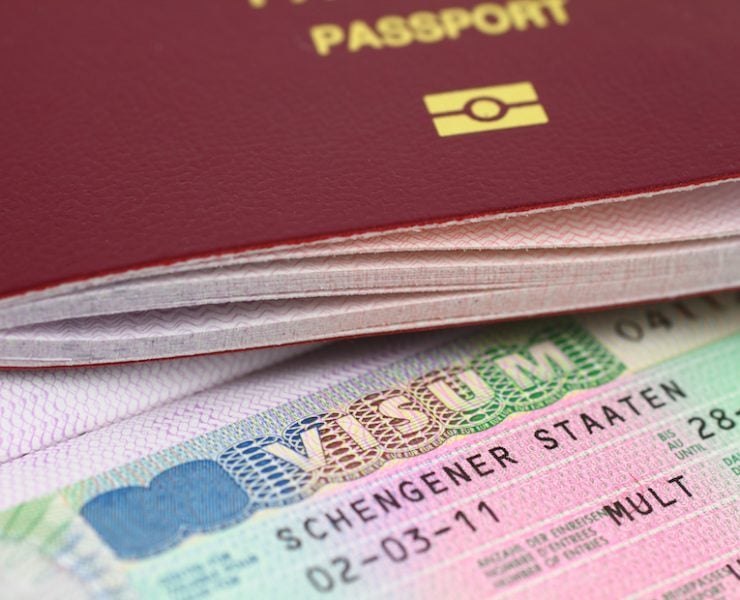
Major Schengen visa update for Bahrain, Oman, Saudi Arabia and India
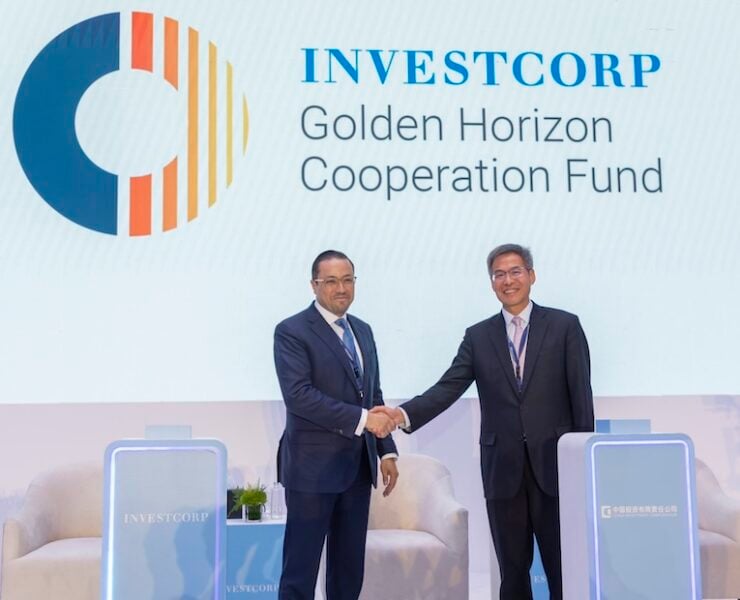
Investcorp announces $1bn GCC fund along with China’s CIC
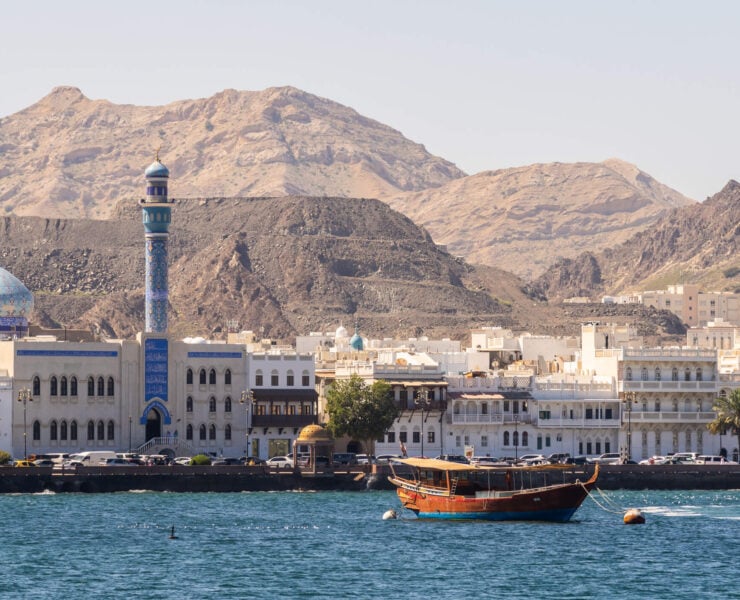
Oman trade deal a priority for India: Reports
Weather forecast: more rain on the way for abu dhabi, dubai says ncm, how uae’s recent floods will impact construction projects, latest issue.
- Saudi Arabia
- Real Estate
- Special Report
- Art & Culture
Advertise With Us
Privacy policy.
© 2021 MOTIVATE MEDIA GROUP. ALL RIGHTS RESERVED.

- Latest News
- North & East
- Environment
- International
- Social Love
- Horse Racing
- World Champs
- Commonwealth Games
- FIFA World Cup 2022
- Art & Culture
- Tuesday Style
- Food Awards
- JOL Takes Style Out
- Design Week JA
- Black Friday
- Relationships
- Motor Vehicles
- Place an Ad
- Jobs & Careers
- Study Centre
- Jnr Study Centre
- Supplements
- Entertainment
- Career & Education
- Classifieds
- Design Week
Year began with a bang for tourism, says Bartlett
Industry earned us$1.27 billion in first quarter of 2024.
THE country earned US$1.27 billion from the tourism industry in the first three months of 2024, Tourism Minister Edmund Bartlett announced Tuesday.
He said that the year began with a bang with tourism experiencing an unprecedented surge, surpassing all projections outlined in the previous fiscal year.
Bartlett, who was opening the 2024/25 Sectoral Debate in the House of Representatives on Tuesday, noted that the revenue came from 1.34 million visitors to the island between January and March.
“That represents 788,000 stopovers or a 7.4 per cent increase. Cruise has come back — 554,560 cruisers — representing a 16.1 per cent increase over the corresponding three months last year,” he said.
According to Bartlett, for fiscal year 2023/24 US$345.8 million or J$53.6 billion in tourism earnings was expected to flow directly into the Government’s coffers.
He said that these direct government revenues comprised Tourism Enhancement Fund (TEF) fees which goes straight to the Consolidated Fund – US$59.2 million or J$9.2 billion; departure tax – US$103.5 million or J$16 billion; airport improvement fee – US$29.6 million or J$4.6 billion; airline passenger levy – US$59.2 million or J$9.2 billion; passenger fees and charges – US$71 million or J$11 billion; and guest accommodation room tax – US$23.3 million or J$3.6 billion.
Bartlett said this does not include the “many billions more in general consumption tax (GCT)” because tourism is the most consumption-driven activity on planet Earth”.
“That’s all people do. They travel to consume and at every point of consumption they pay a tax…When we bring 4.2 million tourists we have just added to the market size of Jamaica and the consumption pattern of the tourists is three to five times that of the locals. So, the propensity to consume drives up the consumption and, therefore, the increase in revenue flows,” he said.
In the meantime, Bartlett noted that preliminary gross earnings for this year is US$4.38 billion.
“Even at 9.6 [per cent] ahead of last year, US$4.38 billion is the largest revenue flow from tourism in the history of the tourism industry in Jamaica,” he said.
Bartlett also highlighted earnings from Jamaica’s international airports in Kingston and Montego Bay which saw impressive growth last year, collectively generating revenue of US$200.28 million or J$30 billion.
He said most of these earnings stemmed from MBJ Airports Limited, operator of Sangster International Airport (SIA), which employs approximately 7,000 people.
HOUSE RULES
- We welcome reader comments on the top stories of the day. Some comments may be republished on the website or in the newspaper; email addresses will not be published.
- Please understand that comments are moderated and it is not always possible to publish all that have been submitted. We will, however, try to publish comments that are representative of all received.
- We ask that comments are civil and free of libellous or hateful material. Also please stick to the topic under discussion.
- Please do not write in block capitals since this makes your comment hard to read.
- Please don't use the comments to advertise. However, our advertising department can be more than accommodating if emailed: [email protected] .
- If readers wish to report offensive comments, suggest a correction or share a story then please email: [email protected] .
- Lastly, read our Terms and Conditions and Privacy Policy
- Privacy Policy
- Editorial Code of Conduct
- Partner with AGBI
Moscow courts UAE to bump up inbound tourism

- Moscow targetting UAE tourism
- International visitors 10% of total
- Gulf tourists spend more
Moscow aims to double the number of annual visitors from the UAE this year, to expand its international tourist base amid headwinds such as the war with Ukraine.
Bulat Nurmukhanov, head of the International Cooperation Division at Moscow City Tourism Committee (MCTC), told AGBI that while the Russian capital’s domestic tourism has broadly recovered since the pandemic, international tourism has yet to do so.
Moscow received 24.3 million visitors in 2023, he said, of which 2.3 million were international and the rest were from elsewhere in Russia. In 2019, Moscow recorded 25 million visitors, of which four million were from overseas.
- In Dubai, it looks like the Russians are staying
- Moscow still a key destination for Middle East tourists
- UAE-Russia trade grows as Putin arrives in Gulf
“Despite the challenges Moscow faces today, it has almost recovered its pre-Covid visitor flow of 2019 – our best year for the industry, helped by the effect of hosting the Fifa World Cup in 2018,” Nurmukhanov said.
“But most of these are domestic tourists. We hope that by working with new markets such as the UAE, we can restructure the international tourism base and attract more visitors from the Emirates and wider GCC.”
Moscow has yet to calculate the number of visitors from the UAE last year, but it is a small proportion of the overseas total, according to Nurmukhanov. However, it is an important source market because of its higher-than-average spend per visit.
“They’re helping load Moscow’s five-star hotels”, he said. These are not as popular among domestic tourists and other nationalities as three and four-star hotels.

Last summer, MCTC revealed that tourists from the Middle East accounted for more than 30 percent of Moscow’s total tourist flow from outside the Commonwealth of Independent States in 2022.
“Middle Eastern countries are among the most promising markets for inbound tourism,” the committee noted.
In the UAE, the number of Russian tourists and investors leapt in the year after Moscow’s invasion of Ukraine, as Russian businesses sought a safe haven free of sanctions imposed on them by the West.
Bilateral trade between the two countries has also risen sharply , by 63 percent between January and September 2023 to $9 billion, according to Russia’s government.
Nurmukhanov said: “We’re already receiving a decent amount of tourists from the UAE and want to make sure that now, we adapt our infrastructure and design new hospitality products, entertainment and offerings that will be in their interest.”
The strategy includes enhancing relationships between Moscow and UAE hotels, travel agents and tour operators; improving restaurants’ halal offerings; translating menus and other literature to Arabic, and promoting popular activities such as bear hunting, helicopter trips and horse riding.
Some Moscow hotels even help GCC tourists to purchase warm clothing for their trip, Nurmukhanov said. Gulf visitors can obtain visas on arrival in Russia, and in November a rapid e-visa service was extended to other countries.
Latest articles
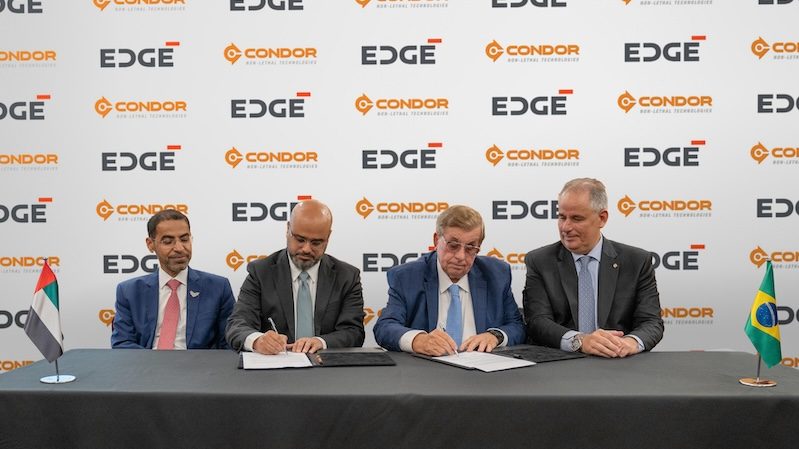
Edge Group buys into Brazilian non-lethal tech
The UAE’s state-owned defence company Edge Group has acquired 51 percent of a Brazilian company which specialises in the manufacture of non-lethal technologies (NLT) such as tear gas and rubber bullets. Condor Non-Lethal Technologies (Condor) has presence in more than 85 countries and is the world’s largest producer of tear gas and related products for […]
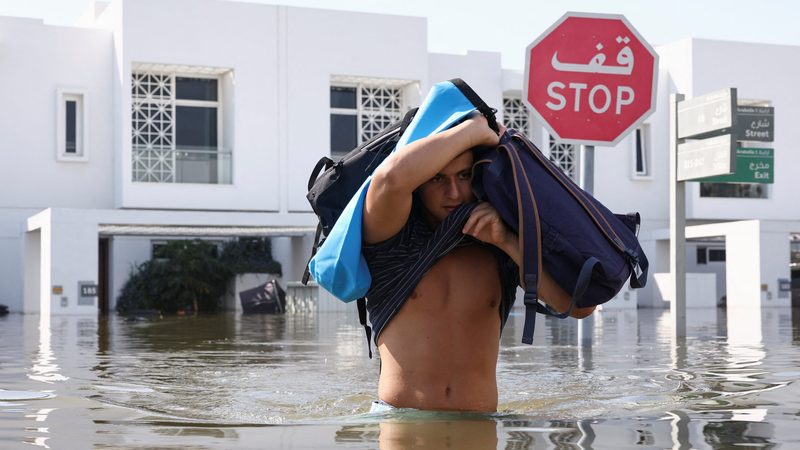
Flood insurance in Dubai under threat says expert
Insurance companies could opt against covering areas of Dubai that were flooded during last month’s heavy rainfall, according to an expert from the S&P Global Ratings agency. Some areas remain badly affected since the torrential storm wreaked havoc across the emirate over two weeks ago, with record amounts of rain over a 24-hour period. It […]
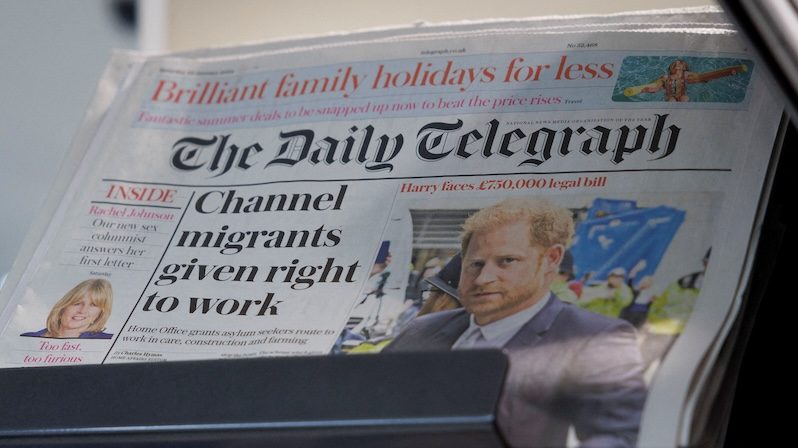
- Media & Advertising
UAE’s RedBird pulls out of Telegraph acquisition
RedBird IMI, partly owned by Abu Dhabi’s International Media Investments, has backed out of plans to acquire the Telegraph Media Group, after the UK government blocked the deal. RedBird IMI’s decision comes after the UK crafted legislation blocking foreign governments from owning British newspapers and news magazines. The company said the deal was “no longer feasible”, Reuters […]

- Infrastructure
Report links e& to acquisition of $8.6bn Dutch telco
The UAE’s e&, formerly known as Etisalat, is planning to acquire Dutch telecom operator United Group BV as part of its overseas expansion strategy, according to a media report. The Abu Dhabi-listed company has been evaluating a possible purchase of United Group, Bloomberg reported, citing informed sources. Private equity firm BC Partners, the current owners […]
Download the AGBI app today

Here are six things proposed Brightline train station could bring to Cocoa, Brevard County

Cocoa officials say having a Brightline train stop in Cocoa will bring major benefits to the city and Brevard County.
Brightline operates 32 trains a day — 16 in each direction — from early morning to late evening on the roughly 3½-hour route between Orlando International Airport and Miami. But it has no stop in Brevard.
The proposed Cocoa station would be built on a part of a 90-acre-plus site near Clearlake Road/U.S. 1 and State Road 528. Some of that land is owned by Brightline and some is owned by Cocoa.
"I'm thrilled that this station is potentially coming," Brevard Zoo CEO Keith Winston, a member of the Brevard County Tourist Development Council, said during a TDC discussion last week of the station and a proposed county grant for the project.
Another TDC member, Palm Bay Mayor Rob Medina, in supporting the proposed grant, said: "This is the right thing to do and the right time for this community."
County grant clears hurdle: Tourism board recommends $5 million Brevard grant to help fund Brightline station in Cocoa
Here are six things that the station could bring to Cocoa and the rest of Brevard County:
Boosting residential, commercial development
Samantha Senger, Cocoa's director of communication and economic development, said she expects a surge in both residential and commercial development near the station, including new restaurants and hotels, creating new jobs in the area, in what will become "an urban, mixed-use destination."
Adding more tourism revenue to Space Coast
Senger said the station could generate anywhere from 78,055 to 160,961 nights a year of room rentals at hotels and vacation-rental properties. She said Brightline passengers generally are relatively high-earners, and are more inclined to spend money at more expensive hotels and restaurants.
Bringing more jobs to Cocoa
All this development could increase job opportunities in the area at hotels, restaurants and retail shops, as well as in construction jobs for these new developments. The station itself is expected to have at least 20 full-time employees.
Additional tax revenue for Cocoa, Brevard
Senger said having the station would create "a prime opportunity for development and growth surrounding the station, including the increase in tax base, not only for the city of Cocoa, but for the county, through property taxes and tourism taxes."
Creating transportation hub
The station will become a "multimodal transportation hub" for tourists that also will include buses to Port Canaveral, to hotels and to attractions; ride-hailing services; and bike-sharing.
Developing 500-space parking lot
Cocoa City Manager Stockton Whitten said initial plans call for about 5.3 acres of the site to be transferred from Brightline to the city of Cocoa for use as a 500-space parking lot. He said details on operations of the parking facility ― including how the parking revenue would be distributed — still are being worked out.
Brightline now has stops at Orlando International Airport, and in West Palm Beach, Boca Raton, Fort Lauderdale, Aventura and Miami. Brightline carried 1.62 million passengers in 2023, and its goal is to have 4 million passengers in 2024.
The rail company announced in March that it also will have a stop in downtown Stuart, after selecting a proposal for a $60 million rail station project there. The station could open as soon as late-2026.
Brightline has plans to extend its route west from Orlando to Tampa in the future, and also could extend service north from Cocoa to Jacksonville.
Dave Berman is business editor at FLORIDA TODAY. Contact Berman at [email protected] , on X at @bydaveberman and on Facebook at www.facebook.com/dave.berman.54
Nuclear waste storage at Yucca Mountain could roil Nevada U.S. Senate race

- Show more sharing options
- Copy Link URL Copied!
More than 3.5 million pounds of highly radioactive nuclear waste is buried on a coastal bluff just south of Orange County, near an idyllic beach name-checked in the Beach Boys’ iconic “Surfin’ U.S.A.”
Spent fuel rods from the closed San Onofre nuclear power plant were supposed to be sent to a long-planned federal repository in Yucca Mountain in Nevada, about 100 miles northwest of Las Vegas.
But vociferous opposition from a broad, bipartisan coalition of political, business, environmental and tribal leaders in Nevada has blocked the creation of the federal graveyard for nuclear detritus from San Onofre, as well as more than 100 other sites across the nation.
Yucca Mountain is a third rail in Nevada politics — akin to the limits on California property tax increases created by Proposition 13. That’s why presidents of both parties have backed away from creating the repository in the Silver State, whose voters are increasingly crucial to winning the White House.
All of which makes comments by Nevada GOP Senate candidate Sam Brown about Yucca Mountain so remarkable.
In recent years, Brown supported opening the facility, calling the failure to do so an “incredible loss of revenue for our state.” Asked about the comments in the context of a Senate race that could determine which party controls the Senate after the November election, Brown did not reiterate his support but said he favors increased efforts to diversify the state’s economy without sacrificing safety.
Yucca Mountain was approved by Congress more than two decades ago, but Nevada politicians of both parties have blocked funding appropriations, so only preliminary work has been completed on the repository.
Brown was asked about the future of the project two years ago.
“If we don’t act soon, other states … are assessing whether or not they can essentially steal that opportunity from us,” Brown said in response to a question at a 2022 Southern Hills Republican Women’s luncheon at Dragon Ridge Country Club in Henderson, Nev.
“We all know that Nevada could use another great source of revenue and it sure would be a shame if we didn’t monopolize on that and become a central hub of new development that we can do at Yucca,” he said in a recording of the meeting obtained by The Times.

Brown’s campaign did not respond when asked whether his remarks represented his current views about Yucca Mountain, but provided a statement from the Army combat veteran.
“I’m always interested in economic opportunities for Nevada that better diversify our economy. As the next Senator, I will look at every avenue available to make Nevada the most prosperous it possibly can be while continuing to protect the safety of our water supply, expand tourism revenue, and grow opportunities for all businesses,” Brown said. “With energy prices doubling last year, we need leadership to explore all energy solutions for a better Nevada.”

Brown is the front-runner in the GOP Senate primary, which will be held on June 11 and determine which Republican takes on Democratic incumbent Sen. Jacky Rosen in the fall.
A spokesperson for Rosen said the Republican’s position endangers Nevadans and makes him unfit to represent the state.
“Nevada Republicans and Democrats have been fighting against storing dangerous nuclear waste at Yucca Mountain for decades, but Sam Brown agrees with the D.C. politicians in Congress who still want to turn Nevada into the nation’s dumping ground for toxic waste,” said spokesperson Johanna Warshaw.

Feds launch search for communities willing to take nuclear waste from San Onofre and other plants
Energy Secretary Jennifer Granholm unveils program to jump-start a process to attract communities to take waste from power plants until a permanent site is built
June 9, 2023
Though the creation of long-term radioactive waste storage on federal land at Yucca Mountain, near a historical nuclear testing range, was approved by Congress in 2002, efforts to build it have been blocked by Presidents Obama, Trump and Biden , in part a recognition of Nevadans’ importance in the nation’s politics as well as the power of Sin City’s casinos.
Three out of four likely voters in the state opposed the project in a 2017 poll conducted for the Reno Gazette-Journal.
Though the state has become increasingly Democratic in recent years and voted against Trump in the last two presidential elections, Nevada is expected to be hotly contested in November. Trump leads Biden by 3.2 points in an average of recent polling there, according to Real Clear Politics.

Trump takes Yucca Mountain off the table. What’s that mean for San Onofre nuclear waste?
White House says no funding for the nuclear waste site will be included in proposed budget.
Feb. 7, 2020
Nevada is also among the states that will determine which party controls the Senate, where Democrats currently have a 51-49 majority. Though Rosen polls better than Biden, the contest is viewed as one of the most competitive Senate races in the nation.
Brown, in his 2022 remarks, said that “a lack of understanding” and “fearmongering” by the late former Sen. Harry Reid, a Democratic powerhouse , and others would ultimately harm the state’s economy.
But many Nevada Republicans also have opposed the project, including former Govs. Brian Sandoval and Jim Gibbons, U.S. Rep. Mark Amodei, former Atty. Gen. Adam Laxalt and former Secretary of State Barbara Cegavske, as well as business groups such as the Las Vegas Chamber of Commerce and the Las Vegas Convention And Visitors Authority. Some rural Nevadans have supported the creation of the repository for economic reasons.
A bipartisan vote to move forward with Yucca Mountain, long blocked by Reid, occurred in 2018 as Rosen, then a member of the House, ran against GOP Sen. Dean Heller. Though the proposal passed the House, Heller effectively blocked funding for the creation of the repository in the Senate before Rosen beat him in the general election.
Trump and Biden have both said they would not fund the project, but Nevadans were alarmed this month by pro-Yucca comments made by lawmakers during a hearing by the House Energy and Commerce Committee that were viewed as a signal there will be renewed efforts to store nuclear waste in their state.
Get the L.A. Times Politics newsletter
Deeply reported insights into legislation, politics and policy from Sacramento, Washington and beyond. In your inbox three times per week.
You may occasionally receive promotional content from the Los Angeles Times.
“Opposition is not safety-related or technical,” said Rep. Cathy McMorris Rodgers (R-Wash.), the committee chair. “It’s political.Opposition from states like Nevada in particular to this program has inhibited congressional appropriations and driven the executive branch to dismantle what had been an otherwise technically successful program.”
Michael Green, a history professor at the University of Nevada, Las Vegas, predicted that Brown’s comments will come back to haunt him.
“I can imagine the ads about the dangers and nuclear power accidents and the like,” Green said. “I don’t think he has done himself any favors.”
More to Read

Red state coal towns still power the West Coast. We can’t just let them die
April 16, 2024
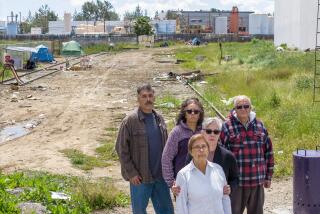
This SoCal hazardous waste facility could get a new permit despite past violations
April 9, 2024

Noxious fumes, contaminated runoff: No easy solution for Chiquita Canyon Landfill woes
March 10, 2024

Seema Mehta is a veteran political writer who is covering the 2024 presidential race as well as other state and national contests. She started at the Los Angeles Times in 1998, previously covered multiple presidential, state and local races, and completed a Knight-Wallace fellowship at the University of Michigan in 2019.
More From the Los Angeles Times
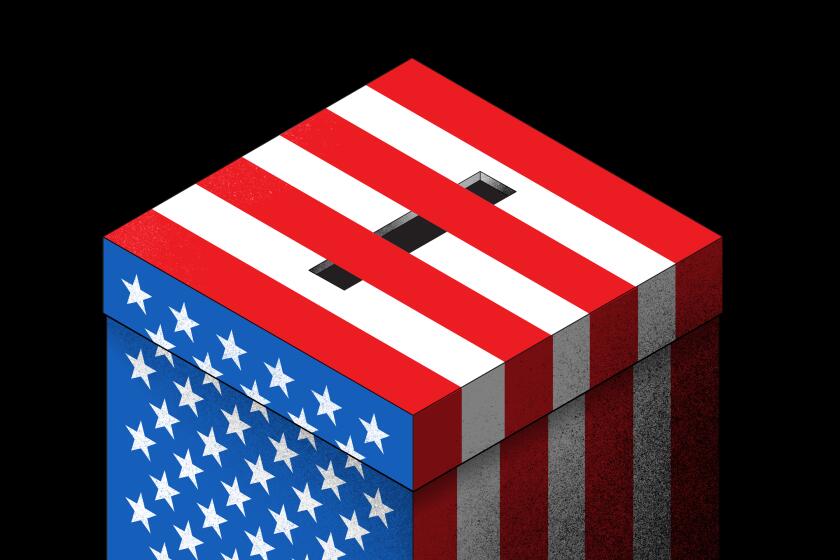
Inside the far-right plan to use civil rights law to disrupt the 2024 election
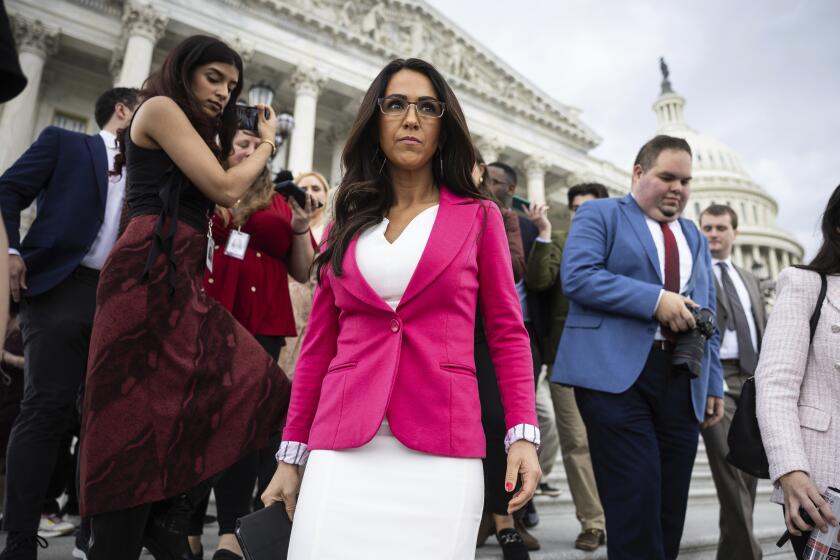
Lauren Boebert is her own best asset — and worst enemy — as she fights to stay in Congress

Trump likens Columbia protests to Jan. 6, part of effort to downplay Capitol attack
April 30, 2024

Litman: Donald Trump was just fined for contempt of court. Could he go to jail next time?
As summer nears, state tourism businesses pin hopes on winning more Pure Michigan funding
As Michigan gears up for another summer tourism season, businesses are hoping to cash in on what they expect will be strong demand throughout the state.
On Mackinac Island, visitors will notice numerous changes, including a two-year restoration at the Grand Hotel and the reopening of the Inn at Stonecliffe following a two-year, $30 million, property-wide transformation. In the Traverse City area, four hotels are expected to open in the next year to accommodate additional out-of-town guests in the popular tourist spot along Lake Michigan.
Operators are hopeful the summer season will be better for tourism in the state after emerging from a mild winter that negatively impacted snow-related businesses, particularly ski hills and nearby lodging. Hospitality and tourism leaders, meanwhile, are seeking the funding they say the state’s Pure Michigan campaign needs to keep visitors — and revenue — flowing into the state.
“We have the best state and I know we have the best campaign,” said Justin Winslow, president and CEO of the Michigan Restaurant & Lodging Association. “We just need to make sure it's in front of as many eyeballs as possible.”
Pushing for promotion funds
Officials with Travel Michigan said earlier this month that results from the state’s Pure Michigan campaign show that travel is on par with pre-pandemic numbers and consistent with national trends. A group of hospitality and tourism leaders would like to keep that momentum going.
Earlier this year, the Michigan Hospitality & Tourism Alliance was formed from a collaboration of statewide and regional organizations seeking to boost funding for the state’s Pure Michigan campaign. The alliance is seeking $50 million for the fiscal year, which would more than triple the current funding.
“We as an industry maybe have become a little more disparate since the pandemic,” said Winslow, a founding leader of the alliance. “We all fought individual battles and had such an existential threat to hospitality, travel and tourism overall. We all went back to our own corners just out of survival instincts. And I don't think we were all communicating what we needed to for the success of all of us overall, and it shows up most notably in what happened to the Pure Michigan budget."
The effort has found some support. On Thursday, the Michigan House Appropriations Subcommittee on Labor, Economic Development, and Lifelong Learning, chaired by Rep. Will Snyder, D-Muskegon, proposed a $40 million budget for Pure Michigan.
Pure Michigan's tourism advertising funding has decreased to about $15 million from roughly $40 million during the past two budget cycles, Winslow said: “That's just far short, I think, of what's necessary to meet the demand out there and the infrastructure that we've created as a state.
“And so I think we're leaving a lot of money on the table for Michiganders by not investing more in the Pure Michigan tourism campaign. And the alliance is trying to create a more unified and hopefully powerful place to make that message heard.”
Earlier this year, Gov. Gretchen Whitmer proposed $20 million for the Make it in Michigan Competitiveness Fund “to build off the iconic Pure Michigan campaign, on top of the $15 million in existing funding for the program, with a focus on talent attraction, labor retention and relocating to Michigan.” It is unclear if any of those dollars would be spent on promotional spending.
The alliance also announced earlier this year the creation of a bipartisan, bicameral “Hospitality & Tourism Caucus" that will work with the alliance to better understand challenges and opportunities impacting the industry. Those members include state Sen. John Damoose, R-Harbor Springs; Sen. Kevin Hertel, D-St. Clair Shores; Rep. Will Snyder, D-Muskegon, and Rep. Nancy DeBoer, R-Holland.
“The travel, tourism and hospitality industry drives the Michigan economy, and nowhere is this more true than in my District in northern Michigan and the Eastern U.P.,” said Damoose, the caucus co-chair, in a statement. “Given the unique challenges faced by this industry in the past several years — from Covid to regulatory burdens — it is critical that legislators come together to help.”
A 2024 SMARInsights Advertising Effectiveness Research for Pure Michigan report released this month showed that Pure Michigan advertising influenced more than 1.5 million leisure trips to Michigan from the national, regional and in-state markets targeted by the campaign. The report showed that out of the $16.9 million spent on advertising in 2023, Michigan saw a return of $9.21 in state tax revenue for each $1 invested.
“I guess it just goes to show that if there’s less advertising, we’ll have to rely on other means to fight for potential business loss,” said Tim Hygh, CEO of Mackinac Island Tourism.
The campaign also has an impact for Metro Detroit, said Christopher Moyer of Visit Detroit, an alliance member: "Every dollar that comes from Chicago to Detroit is one dollar that didn't exist in our economy before but now is here."
Moyer said the requested $50 million is a small fraction of the state’s overall budget — $82 billion for the current fiscal year — and “returns 10X back for communities throughout the state, for small businesses, for union workers, for the hotel workers in the city of Detroit who are part of the Unite Here labor union. They go to work because of visitors.”
Investing in upgrades
On Mackinac Island, businesses are hoping for another strong year when the island opens in May. Among the latest projects is the $30 million transformation of the Inn at Stonecliffe. The property will welcome guests starting in June.
The former mansion, built in 1904, and its 150-acre estate have had numerous uses over the years, including as a ski resort, college and hotel.
The Pulte Family Charitable Foundation took ownership of the property in fall 2022, closed it and restored the mansion, refreshed the summer house and added three three-bedroom cottages and a fourth one-bedroom cottage, said Kevin Doyle, the foundation's chief operating officer.
“All the rooms are kind of a custom bespoke feel,” he said. “In the mansion, there's 16 rooms. Every one of them is different. The summer house, there's 32 rooms. Every floor has a different feel. The mansion is more of a romantic charm feel. And the summer houses is a little brighter family, cheerful feel, if you will.”
The foundation also added a wellness center, two pools, a barbecue pavilion and a four-season event venue overlooking the Straits of Mackinac. The foundation acquired the nearby apple orchard and plans to offer beekeeping lessons and apple picking, Doyle said.
In Grand Traverse County, four hotels are expected to open this year or early next year, including an Avid hotel and a Fairfield Inn, said Trevor Tkach, president and CEO of Traverse City Tourism.
“I think that’s the testament to the commitment and the belief that demand will continue to grow for destinations like Traverse City,” he said. The area held its first International Fireworks Championship in 2023, and will expand this year as a two-day event. Another draw is the nearly 50 wineries in the region.
In Grand Rapids, Doug Small, president and CEO of Experience Grand Rapids, said they are projecting a 1.5% to 3% increase in visitors this year based on a leveling-off of room rates and occupancy: "What I like to say is, 'let's manage expectations.' Because ‘22 and ‘23 were so good … You can't grow that every year. You can maybe maintain it. So we maintain it through this year, or even increase by 1%, that's still a really good year.”
At Brys Estate in Traverse City, Patrick Brys said his family-owned winery is pretty well-staffed for the summer season. The year-round staff hovers around 25 employees. At peak times, the winery employs about 100 people.
The 155-acre property includes a winery, 44 acres of grapes, a guest house and a "secret garden" with 6,000 lavender plants. Business at the winery is up from pre-pandemic levels, with 1,000 daily visitors during peak times.
“People coming up can choose from a lot of different activities as far as wine tasting or specialized wine tours that take people out in the vineyard on stretch golf carts we call our wine wagons,” he said. “Obviously, they can visit our secret garden and lavender operation. And there's picnic areas down there. They can browse a lot of the products that are made from all the distilling of the lavender oils.”
Staffing up for summer
Hiring is also on the minds of tourist destinations and seasonal venues throughout the state. Mackinac Island needs about 5,000 workers on the island every year, Hygh said, with about 1,200 coming to work through H-2B guest worker visa.
“Our members will put an enormous effort in to get by. I think we're going to be fine," he said. "There's nothing that sticks out this year that shows that we would be down, but we continue to just keep advocating and fighting for more H-2B visas. That’s a constant.”
At Rare Bird Brewpub in Traverse City, co-founder Tina Schuett said they are preparing for an influx of visitors as the weather warms. People are drawn to the food and beer scene as well as nearby natural attractions, such as Sleeping Bear Dunes.
To accommodate extra visitors, the pub will expand beyond its year-round staff of 30 to about 40.
“We hire some seasonal staff, usually younger people, high school or college filling some of those gaps that we need just kind of support staff,” Schuett said. “It’s really tricky getting all the staff that we need because everybody in this town is fighting for the same employees and also with COVID we saw a lot of people leaving the industry. "
Schuett’s looking forward to the stressful and exhausting busyness of the summer season, she acknowledged: “It's when we make our money for the year. Our staff love it because they make a lot of money and they do really well.”

IMAGES
VIDEO
COMMENTS
The main purpose of this article is to, through the example of Aksu-Jabagly NR, study how the Tourism Revenue Sharing (TRS) constraints in a tourism destination inhibit the implementation of sustainable tourism development in Kazakhstan. In order to understand the impact of TRS constraints on the implementation of sustainable tourism, we ...
This study reviewed the tourism revenue sharing programme over the last 15 years, including primary and secondary data, which included interviewing more than 300 community members living around three national parks, as well as other relevant stakeholders. The results show that the tourism revenue sharing programme has resulted in a positive ...
TRS Tourism revenue sharing UWA Uganda Wildlife Authority, has managed protected areas since 1996 UNP Uganda National Parks, managed national parks until 1996 Warden in charge Senior UWA manager at the park level and the enforcing of game laws' (Uganda Game Department Archives 1923-1994: 1952, p.7). Experiments in revenue-sharing began in 1952 and
To counter this challenge in Rwanda, a tourism revenue sharing program was initiated in 2005, with 5% (doubled to 10% in 2017) of the park gate fees invested in community development projects. We ...
Tourism Benefit-Sharing (TBS) has gained significant attention in the past two decades as a means of providing economic opportunities and preserving natural protected areas (PAs) and cultural heritage sites globally (Akbar & Yang, 2021; Xu et al., 2009).TBS fosters relationships between local communities and authorities, providing an important factor in creating sustainable destinations and ...
Nature conservation, mainly through shared tourism revenues, contributes to all 17 United Nations Sustainable Development Goals (SDGs) in multiple ways. Benefit sharing mitigated land use conflicts, increased residents' acceptance of nature conservation and reduced pressures on ecosystems. The study demonstrates the complexity of revenue ...
These initiatives have led to the concept of Tourism Revenue Sharing (TRS). The TRS concept is perceived to be a strategy through which livelihoods are improved to create incentives for wildlife conservation among residents in highly populated communities adjacent to protected areas. The critics, however, have challenged the potential of TRS to ...
The influence of tourism revenue sharing constraints on sustainable tourism development: a study of Aksu-Jabagly nature reserve, Kazakhstan April 2021 Asian Geographer 39(2):1-21
The study demonstrates the complexity of revenue sharing arrangements necessary for success, and how to harness sustainable tourism, providing benefits beyond the generation of revenues in which community involvement and the institutional interplay between NP and BR governing stakeholders are key factors.
ABSTRACT Tourism and the sharing of the associated revenues with local people have become a popular strategy for implementing sustainability in nature reserves (NR) or protected areas (PA) globally. Although the local people have obtained some modest economic gains from the development of tourism, especially in infrastructural development, there are still some constraints on revenue sharing.
While the tourism revenue sharing programs have shown positive impacts in some parts of the world (Ahebwa et al., 2012; Leung et al., 2018;Spenceley et al., 2019), researchers continue to question ...
Tourism revenue sharing (TRS) has become a widespread policy intervention in Africa and elsewhere where charismatic populations of wildlife remain. This paper analyzes TRS policy at Bwindi Impenetrable National Park (BINP), Uganda, from a policy arrangements perspective. It is based on data collected at BINP and three surrounding parishes ...
To date tourism revenue-sharing (TRS) programmes have met mixed success. Local conditions and national policies that shape the success of TRS programmes were identified by comparing the experiences of both implementers and beneficiaries of pilot TRS programmes at three parks in western Uganda. Between 1995 and 1998, communities around these ...
Tourism revenue sharing in Rwanda can be traced back to the 1950s when the Belgian colonialists used it as a tool to elicit cooperation from native Rwandans settled in areas adjacent to the country's game reserves. At that time the monetary benefits were delivered to the local
Using Tourism Revenue Sharing to Promote Conservation and Poverty Reduction in Uganda on JSTOR. David Mwesigye Tumusiime, Paul Vedeld, False Promise or False Premise? Using Tourism Revenue Sharing to Promote Conservation and Poverty Reduction in Uganda, Conservation & Society, Vol. 10, No. 1 (2012), pp. 15-28.
A tourism revenue-sharing scheme has helped finance hundreds of community projects and benefitted thousands of people. Supported by. About this content. Usher Komugisha in Kinigi and Andy Nicolson.
This study develops a green tourism supply chain model involving an OTA and a green hotel. The study aims to provide valuable insights for the OTA and hotel in optimizing their decision-making process when they come to reach an agreement on cooperation formats among price-only, cost sharing, and revenue sharing.
Rwanda Tourism Revenue Sharing. Rwanda Development Board (RDB) has for the last twelve years implemented a Tourism Revenue Sharing (TRS) programme, after developing a policy and guidelines in 2005. The policy guidelines followed a national consultation and cover: Goals, objectives and guiding principles for revenue sharing.
According to data shared by Research and Markets, the Saudi revenue from its outbound travel and tourism market is projected to grow at a CAGR of 18.21 per cent from 2021-2028, reaching $27bn by 2028.
Year began with a bang for tourism, says Bartlett ... Thirty-one per cent of the visitors to Jamaica in 2023 used the sharing economy or Airbnb. ... US$4.38 billion is the largest revenue flow ...
Business tourism in Moscow is also expanding. Last year, 3.2 million people (19 per cent of the total tourist flow) came to Moscow for business purposes. Business events are beneficial for the city's economy, providing revenue streams for various contractors all year round, including in the "low" season.
The results show that the tourism revenue sharing programme has resulted in a positive linkage between the national parks and development. Since 2005, ~80% of the funding was used for ...
The majority of Moscow's tourism is from internal visitors but it is hoping the UAE and wider Gulf can change that ... The revenue of Oman's three star to five star hotels rose 18 percent to OR52 million ($136 million) by the end of February 2024, compared to OR44 million a year ago. The revenue increase was driven by an 18 percent year on ...
Adding more tourism revenue to Space Coast. Senger said the station could generate anywhere from 78,055 to 160,961 nights a year of room rentals at hotels and vacation-rental properties.
More than 3.5 million pounds of highly radioactive nuclear waste is buried on a coastal bluff just south of Orange County, near an idyllic beach name-checked in the Beach Boys' iconic "Surfin ...
In 2022, tourism contributed RUB 120 billion to the Moscow budget, which is approximately four times more than in 2010 accounting for RUB 31 billion of total revenues. The city's income from tourism, among other things, makes it possible to improve socially significant infrastructure; for example, the amount can be spent on building 40 ...
As summer nears, state tourism businesses pin hopes on winning more Pure Michigan funding. Candice Williams. ... Michigan saw a return of $9.21 in state tax revenue for each $1 invested.